Photovoltaic Animal Farms Clip Art Photovoltaic on Hog Farms Photos Purchase

Agricultural Land or Photovoltaic Parks? The Water–Energy–Food Nexus and Land Evolution Perspectives in the Thessaly Plainly, Greece
Laboratory of Hydrology and Water Resources Development, Schoolhouse of Civil Engineering, National Technical University of Athens, Heroon Polytechneiou nine, 157 80 Zographou, Greece
*
Author to whom correspondence should be addressed.
Bookish Editors: Kittisak Jermsittiparsert, Thanaporn Sriyakul and Muhammad Haseeb
Received: 29 June 2021 / Revised: thirty July 2021 / Accustomed: vi August 2021 / Published: 11 August 2021
Abstruse
Water, free energy, land, and food are vital elements with multiple interactions. In this context, the concept of a h2o–energy–nutrient (WEF) nexus was manifested every bit a natural resource management approach, aiming at promoting sustainable development at the international, national, or local level and eliminating the negative effects that outcome from the apply of each of the iv resource against the other three. At the same time, the transition to green free energy through the application of renewable energy technologies is irresolute and perplexing the relationships betwixt the constituent elements of the nexus, introducing new conflicts, particularly related to land utilize for free energy production vs. food. Specifically, one of the most widespread "green" technologies is photovoltaic (PV) solar energy, now beingness the third foremost renewable energy source in terms of global installed capacity. However, the growing development of PV systems results in ever expanding occupation of agricultural lands, which are most advantageous for siting PV parks. Using equally report area the Thessaly Obviously, the largest agricultural expanse in Greece, nosotros investigate the relationship between photovoltaic power establish development and food product in an effort to reveal both their conflicts and their synergies.
| «οὐκ ἐπ' ἄρτῳ μόνῳ ζήσεται ἄνθρωπος» (Καινή Διαθήκη, Κατά Ματθαίον 4:iv) |
| "Man shall not live on bread solitary" (New Attestation, Matthew 4:4) |
1. Introduction
Humans need a constant supply of water, food, and energy to alive. These resource are continued to life expectancy, prosperity, and wealth [1], and are necessary in sufficient quantity and quality. The survival limits of humans are 7 days at most without water, and about 45 days without food [ii], which also represents the energy source for the human trunk. Thus, food and water require constant replenishment. Equally energy is essential for prosperity [1], the whole structure of order has been diachronically shaped and has evolved through systematic expansion of its energy consumption.
The multiple and complex interconnections between h2o, free energy, and food, either expressed equally complementarities or conflicts, raised the demand for an integrated viewpoint, to ensure a off-white and sustainable sharing of the 3 vital resources across all scales of interest (international, national, local). In this vein, the concept of the water–energy–food (WEF) nexus is recognized every bit the running paradigm for their combined planning and management [3,4,5,6,vii].
In addition to these three critical elements, land is also a precious resource [8,ix,10]. Land is needed for food production or for cultivating biofuels, both raising water needs for irrigation [eleven,12,thirteen,14]. Recently, it has too been used for the installation of all kinds of infrastructures that are associated with free energy and water production [fifteen]. In this vein, a major disharmonize arises within the WEF nexus, given that land is their common interface [xvi,17,18].
One of the most important aspects of the global shift towards sustainability is the transition to renewable energy (RE) technologies. The shift to renewables introduces further challenges within the WEF nexus. A feature example is the worldwide expansion of photovoltaic (PV) free energy, likewise emerging from the attractive financial opportunities offered, which has resulted in an expanding occupation of agronomical country, since the latter offers significant advantages for installing PV panels. Hence, the motivation of this research is the growing concern over the degradation of agricultural and livestock production equally a upshot of the occupation of agronomical land for the establishment of PV power stations. For this reason, an attempt is made here to investigate the competitive relationship between PV power plants and nutrient product. As a case written report, we consider the area of Thessaly, which is one of the key areas for the primary sector in Hellenic republic and the biggest agricultural area in Greece. The vast surface area of flatland, in combination with the abundance of solar resource, favors the evolution of PV systems, attracting a big number of investors. Our analyses aim at the assessment of transforming the plain from a nutrient production expanse to an energy production surface area.
2. Energy Flow: From Sun to Humans
The Sun and World are the sources of WEF nexus which are precious goods. Koutsoyiannis [19] notes that:
The total energy involved in the hydrological bicycle is 1.290 × 1024 J twelvemonth−one or 1290 ZJ yr−1. This is about one-half the global solar energy absorbed by the World (161 W m−2, according to Trenberth et al. 2009 [xx]). Compared to the human energy production, which in the by decade was near 170,000 TWh yr−1 or 0.612 ZJ year−i (corresponding to the year 2014; Mamassis et al. 2021 [21]), the full energy involved in the water cycle is 2100 times higher. Put differently, the total homo energy production in 1 yr equals the free energy consumed (or released) by the hydrological bicycle in near iv h.
Summarizing, we conclude that one-half of the free energy provided by the Sun is being consumed in the water cycle, and its consumption is a necessary condition for human life [22]. A pocket-size part of the other one-half is being used to convert inorganic affair to organic affair [23]. Humans consume a pocket-sized part of the organic matter every bit food (animals, plants) and another part equally energy (wood, oil [24], etc.), which is essential for prosperity (Figure 1).
iii. The Contest between WEF
An important issue is to detect and describe the interactions within the WEF nexus. We volition explore the interaction in clockwise direction (Effigy 2a) and counter-clockwise direction (Figure 2b).
3.1. Clockwise Direction
3.i.1. Water to Energy
-
There are several water and free energy interactions [25].
-
Hydroelectric free energy can simply exist generated if water is readily available in rivers or reservoirs [26,27].
-
While hydroelectric energy does non consume water, the tillage of plants for biofuel [28,29,thirty,31] consumes significant amounts of h2o, so we notation a subconscious toll of water in this process [32,33].
3.1.ii. Energy to Nutrient
-
Solar energy is a bones requirement for the cultivation of plants. The production of food is an energy expensive process. Nutrient product consumes globally 30% of total energy [26] (harvesting, tillage, processing, storage).
-
The production of fertilizers is an energy intensive process.
three.one.3. Food to H2o
-
Water is incorporated within the produced food.
-
Fertilizers have a negative upshot on the quality of h2o and have serious implications for ecosystems.
3.ii. Counterclockwise Direction
three.2.1. Water to Food
-
Yields of irrigated agricultural land are college.
3.2.2. Nutrient to Energy
-
By consuming nutrient, nosotros provide energy for our organs to office [34]. Interestingly, the human encephalon consumes ~20% of the body'due south energy (350 or 450 calories per day), despite making up just ~2% of the body'south mass [35,36].
-
Biofuels are produced by food (eastward.g., corn, soya).
-
Country is used for mining, cultivation of biofuel plants, and PV panels, creating contest to the cultivation of food.
3.2.3. Energy to Water
-
Groundwater (which needs energy to be pumped in order to be useful) is the world'due south most extracted natural source. Koutsoyiannis estimates groundwater uses from several studies, based on global hydrological models and GRACE information, to be 300 km3/year in contempo years [19].
-
Natural h2o, make clean h2o, and wastewater need free energy for treatment and transportation.
-
Water distribution and especially desalination are energy intensive processes.
3.three. Country Use Related to Nutrient, Energy, and H2o
-
It is important to highlight the competitive relationship of land uses with the water–food–energy nexus. Land can be used:
-
For nutrient production
-
For energy production
- ○
-
cultivation of biofuel plants,
- ○
-
installation of PV panels, and
- ○
-
cosmos of reservoirs in hydroelectric dams.
Biofuel plants utilize land and water to produce energy instead of food. PV panels use land to produce energy without water. Using the land for reservoirs, hydroelectric projects produce energy using water.
four. The Role of WEF for Humans
Clarifying the role of WEF nexus for humans, this paper begins correlating life expectancy with the availability of three elements.
4.one. H2o
Water is a fundamental component of living. Although safe drinking water technologies have improved in contempo decades, two.2 billion people worldwide notwithstanding do not accept access to condom drinking water, and more than half of the world's population has no access to safe sewage [37]. Globally, approximately 70% of freshwater withdrawals are irrigating agriculture areas [38] and ~20% are used for industrial purposes [39].
Urbanization and high living standards increment the water withdrawal worldwide over the last 100 years [40,41]. As the population is growing but equally fast, water withdrawal per capita appears to remain constant (Figure 3a). In a country's average data, water withdrawal per capita is not related to life expectancy, every bit the data evidence much besprinkle (Effigy 3b). This is justified considering natural factors, such every bit the climate and economic contour of each country [21,42] (Figure 4).
four.2. Energy
Energy is the global currency as information technology is strongly correlated with prosperity (life expectancy and GDP per capita). Wilhelm Ostwald was the first to highlight the correlation between energy consumption and life expectancy, in 1909 [49]. The information in Effigy 5 verify it.
In that location is a large inequality of per capita energy use betwixt countries. In countries with high Gross domestic product, the largest share of energy is used for transport and heating. In countries with depression Gross domestic product, cooking has the highest share in free energy consumption (Figure vi) [fifty].
4.three. Food
Food is a commodity derived from plants and animals. Human diet provides nutrients such as carbohydrates, fats, fibers, protein, vitamins, and minerals. These and other chemical compounds are essential for basic bodily function.
Food production began with small farms and animal husbandry. Population growth and urbanization acquired significant changes to farm production with new, optimized farming methods. As modernistic agronomics needed less workers, information technology favored the influx of population into cities.
Food is at present based on primary production (agriculture) and secondary (industrial food processing). Product and consumption are continued through supply chains, trade, markets, prices, and price volatility. There are several problems with food direction: 1.half-dozen billion tons every year are wasted (1.3 billion tons are edible) [53] but many people do not have admission to food in developing countries [54,55,56].
Food is closely correlated with life expectancy (Figure vii and Effigy 8). It is obvious that living prosperously is associated with college caloric supply, following the same pattern of life expectancy and GPD per capita.
5. Overview of WEF, Land Synergies, and Conflicts
5.ane. Studding the WEF Nexus
References to "water, energy, nutrient" in papers and manufactures tin can be found starting in the 1960s (Figure 9). In 2009, Koutsoyiannis et al. [59] connected the competition of these issues and the necessity to study them together under the prism of uncertainty. The nexus'southward potential has been clear among the scientific community since 2011 [53,60] (Effigy 10 and Figure 11) and in recent years, the WEF nexus has been of particular interest to the scientific customs [61,62,63,64]. Furthermore, there are many attempts at the transition from the theoretical aspects of WEF nexus to the applied ones [65].
5.2. Club, Water–Food–Energy Nexus, and Optimization Aspects
In prehistory, humans relied on energy and water to transition from hunter-gatherers to farmers, and this gave them the ability to cluster in smaller spaces like cities [1] and the increase of clustering gives rise to civilization [66]. Today, humanity is facing a major challenge: the rapidly growing need for WEF. Population growth, the different ways of life of each society, and the urgent need to improve WEF security for the poorest are putting increasing pressure on resource [67]. Unless there are pregnant changes in production and consumption patterns, agricultural production should increase by about lx% until 2050 and global electricity production is projected to increment past almost 60% over the adjacent ten years [68,69]. Thus, we annotation that a careful management of the nexus is required.
Throughout history, there was inequality in the distribution of resources. At present, in order to show the inequality of distribution, nosotros use the entropic index of inequality [1] ΔΦ: for energy: 0.92; for food: −0.51. Note that Φ denotes the entropy and ΔΦ is the departure of the entropy of the particular distribution of income from the entropy of the exponential distribution with equal mean value. As ΔΦ approaches 0 or becomes negative the equality increases and equally ΔΦ approaches 1, inequality is maximized.
Effigy 12a,b show the plots of exceedance probability related to energy consumption and daily caloric supply in different countries for the yr 2010. Data show a wide range of inequality in energy use. In contrast, equally diet needs have small range in caloric supply, the inequality in caloric supply is faint.
Notably, the optimization of WEF nexus management is already function of the evolution process of Homo sapiens. Related papers have given an overview of the relationship, through the evolution process, of Homo sapiens with items such as:
-
h2o and food consumption [66],
-
walking on 2 anxiety which was an free energy-saving step [seventy], and
-
the part of the brain, which is more free energy efficient than in animals [71].
As the WEF nexus is so critical for human survival, and the abundance of resource is connected to life expectancy (Figure 3, Figure four, Figure 5, Figure 6, Figure seven and Figure eight), an optimization of WEF nexus management is required. In this attribute, the target should exist to isolate the individual parts of the nexus and minimize the associated conflicts, e.g., h2o for nutrient, water for energy, energy for water, energy for nutrient, fertilizers for food, etc.
In these circumstances, an important issue is to ensure secure access to the WEF nexus for all people, reducing inequalities.
5.3. PV Evolution in Agronomical Lands
Since the beginning of the 21st century, the penetration of RE sources has been growing quickly, and their share in the electricity mix is expected to farther increase. Despite the big advantages of RE over conventional fossil fuels, in that location is a growing business over the world that large-scale RE infrastructures will readapt other land uses, thus resulting in astringent socio-economic and environmental impacts and irreversible alterations to landscapes [72,73,74,75].
After hydroelectric and air current energy, PV energy is the tertiary most of import form of RE worldwide. Global PV capacity has substantially grown from around 5 GW in 2005 to 714 GW in 2020 [76]. This expansion is explained by the rapid fall in costs for solar PV, on the one mitt, and the financial and legislative motivations provided at the national and international level (e.g., the Eu), on the other. In this context, i of the most typical conflicts amid RE and state resources involves the development of PV solar plants in rural areas, and specially over agricultural lands.
At that place are multiple reasons making agronomical lands so attractive for the deployment of PV systems on a large scale. It is well known that the electrical ability of solar PVs is a conversion of the incoming solar radiation, straight and diffuse, which depends on the geographic location and strongly influenced by the local topography [77]. On the other hand, the efficiency of PV panels, although primarily dependent on the technical characteristics of the specific system (silicon type, cell layout and configuration, console size, color of protective backsheet, etc.), is also significantly affected by the local microclimate, mainly the temperature. It is recognized that the about suitable land conditions for maximizing PV potential are croplands, grasslands, and wetlands, which are characterized past plentiful insolation, light winds, moderate temperatures, and depression humidity [78]. Apparently, croplands are more suitable since they combine a relatively low cost for land reservation, easy accessibility to the route and electrical grid network, and minimal interventions for the preparation of the installation terrain (e.g., grading). Hence, they are strongly preferred past investors seeking evidently areas with such benign characteristics to deploy big-scale solar parks (indicatively, a solar park of 1 MW capacity needs a development area of about 2.6 ha). On the other mitt, an increasing number of landowners and farmers find more gainfulness to grant their lands to energy investors, in social club to ensure a steady and low-risk income, which may exceed their net profit from farm production.
Under this premise, from the first of RE expansion, there is a long-standing word on the impacts of capturing agronomical land for the installation of large-scale PV systems [79,eighty,81]. Apart from the obvious question, i.e., whether it is possible to fulfill the needs for nutrient and energy nether limited land resources [82,83], PVs in agricultural areas are also associated with environmental degradation, including landscape deterioration [84,85], land take, soil deposition, and loss in traditional cropland and biodiversity [86].
However, recent advances under the h2o–free energy–land–food nexus approach take brought to light innovative solutions for overcoming the conflicts between energy and land uses and co-developing the same land area for both solar PV ability and conventional agriculture. In this respect, there is a global involvement in the then-called agrophotovoltaic or agrivoltaic systems [87,88,89], which are suitable for shade-tolerant crops and they also offer quite pregnant advantages with respect to PV efficiency. The feel reported so far is quite encouraging. Nevertheless, information technology is generally accepted that such synergetic schemes are economically effective under specific climatic conditions (i.due east., arid or semi-arid) and for locations with intense competition for country resources, due east.g., islands [90].
6. Case Written report: The Military camp of Thessaly
half dozen.1. Overview of the Food–Land–Energy Nexus in Thessaly
The district of Thessaly extends over an area of 1,403,600 ha in primal Greece, where 403,045 ha is the cultivated country (Effigy 13), thus roofing over 10% of the state's agronomical land [91,92]. The extensive agricultural production in the plain of Thessaly is facilitated by the topography and the fertile land resource.
Twoscore percent of cultivated land is irrigated, which puts pressure on both surface and groundwater resource, since irrigation of crops is the largest consumer of water (Table 1). The estimated annual h2o intake for all uses is 1422 hm3 and 24% concerns surface water, while 76% comes from drilling groundwater [94,95]. The annual deficit of groundwater is 474 hm3 and is caused by the intensive and unsustainable use mostly of groundwater.
The annual crops are fully mechanized in all production stages from sowing to harvest. As an gild of magnitude, modern farming consumes 25 GJ/ha/y [96,97,98,99,100,101,102,103,104,105,106,107], thus resulting in the almanac energy needs for cultivation being about 8 meg GJ (or 2.eight TWh). For comparison, the full annual free energy consumption in Greece in 2019 was most 319 TWh, of which 48 TWh was the electric energy demand [108].
In recent years, the involvement of investors in Greece has been focused on RE, also raised by significant fiscal incentives provided past national and the European union legislation. The installation of renewables in Hellenic republic is controlled by the Regulatory Authority for Free energy (RAE). RAE is an independent authority established by Law 2773/1999 [109], which harmonized the Greek legal order with EU Directive 96/92/EC [110] and is empowered to monitor the performance of all sectors of the energy market place.
Afterward wind energy, solar energy, mainly by ways of PV parks, is the more often than not developed source of renewable energy in Hellenic republic. It is remarkable that the sharing of solar energy to the electricity mix of the country increased from less than 0.3% to 9.0%, in the last decade. In particular, the Thessalian plain is strongly beneficial for installing PV panels, since it is a vast flat land, receiving an boilerplate annual solar free energy of 1440 to 1590 kWh/k2 [111]. Figure xiv and Figure xv show the country uses over Thessaly, too highlighting the licensed solar parks exceeding 1 ΜW [112].
According to a recent Greek law (valid from March 2020) [113], the maximum commanded solar power capacity in agronomical state of Thessaly is 2758 MW. The solar capacity and so far is 1711.5 MW, while the licensed parks cover ~1% of cultivated land. Based on approximate data from the Global Solar Atlas [114], we estimate that the current solar energy production in Thessaly is 1485 kWh/kWp. This means that currently, Thessaly produces almost nine million GJ (nigh ii.5 TWh). Bold that all potential solar capacity allowed by the police force is installed, the produced annual energy will be approximately 15 one thousand thousand GJ (iv.ii TWh), which exceeds the free energy needs for food production in the unabridged area of Thessaly.
vi.ii. Quantitative Analysis
In order to evaluate the conflicts and possible synergies between the iii resource of interest, i.eastward., food, land, and solar energy, we employed an economic comparison of PV panels development vs. agricultural activity, having as "common denominator" the associated occupied expanse [115]. As a proof of concept, we considered two culling cultivations, namely wheat, which is the traditional agricultural production of Thessaly, and kiwifruit. The latter is native to the Yangtze Valley of northern China and Zhejiang Province on the declension of eastern China [116]. Currently, the main region of kiwifruit cultivation in China is the primal and lower Yangtze River Valley.
Climatic information shows that kiwifruit native land has the same range of temperatures with Thessaly (Figure 16a) simply totally different characteristics of rainfall (Figure 16b). Specifically, the annual average rainfall in Thessaly is about 500 mm [94] and the boilerplate of three different areas in Yangtze river valley is almost 1600 mm. In order to optimize the kiwifruit production and suit cultivated country of Thessaly's plainly, to the environmental weather condition of Yangtze river valley, farmers demand 7000–8000 g3 of h2o per hectare for irrigation [117,118]. On the other paw, the water needs of wheat are much more limited and they do not exceed 1500 miii/ha.
Two types of analyses were conducted. The beginning involved the comparison of the iii alternatives on a unit surface area basis (per hectare). The main outcomes are summarized in Tabular array 2. Since the total free energy consumption per capita in Greece for domestic uses is about 110 GJ [108], i hectare of PV panels can fulfill the energy needs of 19 people. On the other paw, the daily food caloric supply per capita in Greece is about 3350 (five.2 GJ annually). Under the hypothetical context that people fulfill their nutrient needs exclusively by wheat or kiwifruit, we conclude that one hectare of cultivated land equals the caloric needs of x–19 and twenty people, respectively (annually needs ~912,500 kcal). We remark that while kiwifruit is more than efficient from a marketplace point-of-view (1 ha can produce upwardly to 40 t, in contrast to wheat that produces but 4–7 t), information technology needs much more water for irrigation.
The second analysis involved the evolution of a real-earth PV park in Cardinal Thessaly, that extends over an expanse of ane.three ha [102]. The total power capacity of the plant is 500 kW. For the interpretation of hateful annual energy product, nosotros considered the typical value of 1485 kWh/kWp, increased by 15% under the assumption of applying a solar module tracking organization. Taking an investment period of 20 years, a financial assay was employed [115] and contrasted to the development of the two alternative food sources, i.e., kiwifruit and wheat. Figure 17 illustrates the financial flows for:
-
Solar parks, based on contempo (2021) prices of electricity produced past PV parks;
-
Fiscal needs and aspects of the cultivation of kiwifruit in 2021 prices;
-
Financial needs and aspects of the cultivation of wheat in 2021 prices.
The above analysis indicates that an investment in kiwifruit is highly efficient (almost the same with PV panels), and needs less than half of the investment for PV panels. The time needed for the depreciation of the investment price for kiwifruit crops is about 7 years, while for PV panels it is around 12 years.
Under an extreme scenario of agronomical development based on kiwifruit over the entire expanse of Thessaly, the total h2o needs will reach 3000 hm3, while the bachelor surface water resources are but 340 hm3 [94] (Figure xviii). Evidently, this a non-sustainable selection, given that the groundwater resources of Thessaly are nether substantial stress.
Finally, in Figure 19, we plot the energy balance of the three alternatives, on a life-wheel basis. In terms of pure product, the PV development is by far more beneficial.
7. Conclusions
The WEF nexus is very crucial to human survival, economic system, and sustainable development, every bit the supply and consumption of each of the three elements is top priority. As need grows, there is increasing competition among water, energy, agriculture (nutrient), and other sectors with unpredictable impacts for livelihoods and the environment. The report of the WEF nexus may lead to beneficial changes to the ways that nosotros produce and eat. Yet, these fundamental elements across the WEF systems are highly interconnected with a complex and strongly non-linear relationship and the research of their synergies and conflicts is very important. It is interesting that the scientific customs focused on it just in the final decade.
Here, we implemented a comparative assay of PV development vs. agronomical activity in the master agricultural region in Greece, Thessaly. In particular, we investigated iii possible scenarios: (a) the evolution of solar infrastructures without agricultural use of country, (b) land usage exclusively for wheat cultivation, and (c) country usage exclusively for kiwifruit cultivation. Although the kiwifruit product gives a much higher economical gain than the wheat tillage, producing most equivalent results with wheat in term of calories, the water demands are likewise high, making this option unsustainable. On the other paw, the installation of PV panels, from an economic perspective, is more cost effective than the other two land utilise options.
Initially, the development of PV parks requires a large investment fund, if compared with the other two options, but in its life bike, the revenue of free energy production and the negligible water demand highlight this scenario as the best solution for our case written report. However, whereas energy is essential for prosperity, information technology is not edible, thus food security is starting time priority.
Moreover, we observed that successful cultivation paradigms (such as kiwifruit pro-duction) and ideas which are not adjusted to the local characteristics of the area could be very harmful and very unsustainable.
The problem described in this article tin serve as a framework for future actions for sustainable evolution within the water–energy–food–land nexus. This will require extending the research to other areas, with varying hydroclimatic and socioeconomic characteristics, and accounting for various types of crops. This will allow extracting more generic conclusions with respect to the conflicts and synergies between all elements of the nexus.
Writer Contributions
Conceptualization, D.K. and M.-F.S.; methodology, P.S. and G.-F.S.; validation, G.-F.Due south. and A.Due east.; formal analysis, M.-F.Due south. and P.S.; investigation, D.K., G.-F.S., and P.S.; information curation, Thou.-F.Southward. and P.Southward.; writing—original draft preparation, Chiliad.-F.Due south., D.K., and A.Eastward.; writing—review and editing, G.-K.Due south. and Thousand.C.; visualization, G.-F.S.; supervision, D.K.; projection assistants, One thousand.-F.Due south. All authors take read and agreed to the published version of the manuscript.
Funding
This research received no external funding.
Institutional Review Board Statement
Not applicable.
Informed Consent Argument
Not applicable.
Data Availability Statement
The databases that have been used are referred to in detail in the citation given in the text and are publicly available. In addition, we have used information from: Google Books, Ngram Viewer, available online: https://books.google.com/ngrams (accessed on 27 June 2021) and Scopus, available online: https://www.scopus.com/ (accessed on 27 June 2021).
Acknowledgments
We give thanks the editors of Sustainability-MDPI for the invitation to contribute with a paper and the processing of the newspaper, as well as 4 anonymous reviewers for comments that helped improve and enrich the manuscript.
Conflicts of Involvement
The authors declare no conflict of interest.
References
- Sargentis, G.-F.; Iliopoulou, T.; Dimitriadis, P.; Mamassis, N.; Koutsoyiannis, D. Stratification: An Entropic View of Society'south Structure. World 2021, 2, xi. [Google Scholar] [CrossRef]
- Pimentel, D.; Pimentel, M. World Population, Food, Natural Resources, and Survival. Earth Futures 2003, 59, 145–167. [Google Scholar] [CrossRef]
- Gulati, Yard.; Jacobs, I.; Jooste, A.; Naidoo, D.; Fakir, S. The H2o–energy–food Security Nexus: Challenges and Opportunities for Food Security in S Africa. Aquat. Procedia 2013, i, 150–164. [Google Scholar] [CrossRef]
- Simpson, G.B.; Badenhorst, J.; Jewitt, G.; Berchner, Thou.; Davies, E. Competition for State: The Water-Energy-Nutrient Nexus and Coal Mining in Mpumalanga Province, South Africa. Front. Environ. Sci. 2019, 7, 86. [Google Scholar] [CrossRef]
- Yu, L.; Xiao, Y.; Zeng, 10.; Li, Y.; Fan, Y. Planning water-free energy-food nexus arrangement management nether multi-level and doubtfulness. J. Clean. Prod. 2020, 251, 119658. [Google Scholar] [CrossRef]
- Del Borghi, A.; Moreschi, L.; Gallo, M. Circular economy approach to reduce water–energy–food nexus. Curr. Opin. Environ. Sci. Health 2020, 13, 23–28. [Google Scholar] [CrossRef]
- Food and Agriculture Organization of United Nations. The Water-Energy-Nutrient Nexus A New Approach in Support of Food Security and Sustainable Agriculture. Rome. 2014. Bachelor online: http://www.fao.org/3/bl496e/bl496e.pdf (accessed on 28 June 2021).
- Rulli, M.C.; Bellomi, D.; Cazzoli, A.; De Carolis, 1000.; D'Odorico, P. The water-land-food nexus of first-generation biofuels. Sci. Rep. 2016, 6, 22521. [Google Scholar] [CrossRef]
- Magliocca, N.R. Amanuensis-Based Modeling for Integrating Human Behavior into the Nutrient–Energy–Water Nexus. Land 2020, 9, 519. [Google Scholar] [CrossRef]
- Berndes, G.; Cowie, A.L.; Dale, V.H.; Kline, Thousand.L.; Johnson, F.10.; Langeveld, H.; Sharma, N.; Watson, H.; Woods, J. Energy and Land Apply; United Nations Convention to Compact Desertification (UNCCD) and International Renewable Free energy Agency (IRENA), 2017. Available online: http://iinas.org/tl_files/iinas/downloads/state/IINAS_2017_UNCCD-IRENA_Energy-Land_paper.pdf (accessed on 27 June 2021).
- Food and Agronomics System of the United Nations. BIOFUELS: Prospects, Risks and Opportunities; Food and Agriculture Organization of the United nations: Rome, Italian republic, 2008; Bachelor online: http://world wide web.fao.org/3/i0100e/i0100e00.htm (accessed on 27 June 2021).
- Popp, J.; Lakner, Z.; Harangi-Rákos, M.; Fári, M. The consequence of bioenergy expansion: Nutrient, energy, and surroundings. Renew. Sustain. Energy Rev. 2014, 32, 559–578. [Google Scholar] [CrossRef]
- Stenzel, F.; Greve, P.; Lucht, W.; Tramberend, Due south.; Wada, Y.; Gerten, D. Irrigation of biomass plantations may globally increase water stress more than climate change. Nat. Commun. 2021, 12, 1–9. [Google Scholar] [CrossRef] [PubMed]
- Marta, A.D.; Natali, F.; Mancini, M.; Ferrise, R.; Bindi, M.; Orlandini, Due south. Free energy and H2o Use Related to the Cultivation of Energy Crops: A Case Study in the Tuscany Region. Ecol. Soc. 2011, 16. [Google Scholar] [CrossRef]
- Teter, J.; Yeh, Due south.; Khanna, M.; Berndes, G. Water impacts of U.S. biofuels: Insights from an assessment combining economic and biophysical models. PLoS 1 2018, 13, e0204298. [Google Scholar] [CrossRef]
- OECD. The Land-Water-Free energy Nexus; OECD Publishing: Paris, France, 2017. [Google Scholar]
- Hoff, H. Managing the Water-State-Energy Nexus for Sustainable Development. United Nations Relate. Available online: https://www.un.org/en/relate/article/managing-water-land-energy-nexus-sustainable-development (accessed on 29 June 2021).
- Spang, East.S.; Moomaw, W.; Gallagher, K.S.; Kirshen, P.; Marks, D.H. The water consumption of free energy production: An international comparison. Environ. Res. Lett. 2014, 9, 105002. [Google Scholar] [CrossRef]
- Koutsoyiannis, D. Revisiting the global hydrological bicycle: Is it intensifying? Hydrol. Earth Syst. Sci. 2020, 24, 3899–3932. [Google Scholar] [CrossRef]
- Trenberth, K.Eastward.; Fasullo, J.; Kiehl, J. World's Global Energy Budget. Balderdash. Am. Meteorol. Soc. 2009, ninety, 311–324. [Google Scholar] [CrossRef]
- Mamassis, North.; Efstratiadis, A.; Dimitriadis, P.; Iliopoulou, T.; Ioannidis, R.; Koutsoyiannis, D. Water and Free energy. In Handbook of Water Resources Management: Discourses, Concepts and Examples; Bogardi, J.J., Tingsanchali, T., Nandalal, Chiliad.D.W., Gupta, J., Salamé, L., van Nooijen, R.R.P., Kolechkina, A.G., Kumar, N., Bhaduri, A., Eds.; Springer Nature: Cham, Switzerland, 2021; Chapter xx; pp. 617–655. [Google Scholar] [CrossRef]
- Franck, Due south.; Von Bloh, West.; Müller, C.; Bondeau, A.; Sakschewski, B. Harvesting the lord's day: New estimations of the maximum population of planet World. Ecol. Model. 2011, 222, 2019–2026. [Google Scholar] [CrossRef]
- Lewis, F.J. Photosynthesis and Related Processes. Nat. Cell Biol. 1945, 156, 487–488. [Google Scholar] [CrossRef]
- Kvenvolden, Thousand.A. Organic geochemistry—A retrospective of its commencement 70 years. Org. Geochem. 2006, 37, 1–xi. [Google Scholar] [CrossRef]
- McMahon, J.Due east.; Price, S.One thousand. H2o and Energy Interactions. Annu. Rev. Environ. Resour. 2011, 36, 163–191. [Google Scholar] [CrossRef]
- IRENA. Renewable Energy in the H2o, Energy & Food Nexus. 2015. Available online: https://www.irena.org/-/media/Files/IRENA/Agency/Publication/2015/IRENA_Water_Energy_Food_Nexus_2015.pdf (accessed on 27 June 2021).
- Rehman, Due south.; Al-Hadhrami, Fifty.Grand.; Alam, 1000. Pumped hydro energy storage organisation: A technological review. Renew. Sustain. Energy Rev. 2015, 44, 586–598. [Google Scholar] [CrossRef]
- Castillo, R.M.; Feng, Thou.; Hubacek, One thousand.; Sun, 50.; Guilhoto, J.; Miralles-Wilhelm, F. Uncovering the Green, Blue, and Grey H2o Footprint and Virtual Water of Biofuel Production in Brazil: A Nexus Perspective. Sustainability 2017, 9, 2049. [Google Scholar] [CrossRef]
- Gerbens-Leenes, P.; van Lienden, A.; Hoekstra, A.; van der Meer, T. Biofuel scenarios in a h2o perspective: The global blue and green water footprint of route ship in 2030. Glob. Environ. Chang. 2012, 22, 764–775. [Google Scholar] [CrossRef]
- Gerbens-Leenes, Due west.; Hoekstra, A.; van der Meer, T.H. The water footprint of bioenergy. Proc. Natl. Acad. Sci. U.s.a. 2009, 106, 10219–10223. [Google Scholar] [CrossRef] [PubMed]
- Water Implications of Biofuels Production in the U.Southward; Study in Brief; The National Academies, October 2007; Available online: https://www.nap.edu/resource/12039/biofuels_brief_final.pdf (accessed on 27 June 2021).
- Geoff, K.; Jackson, S.; Napoleon, A.; Comings, T.; Ramey, J.A. The Subconscious Costs of Electricity: Comparing the Hidden Costs of Power Generation Fuels; Civil Gild Institute: Cambridge, Uk, 19 September 2009; Available online: https://world wide web.synapse-energy.com/sites/default/files/SynapseReport.2012-09.CSI_.Subconscious-Costs.12-013.pdf (accessed on 27 June 2021).
- Yergin, D.; Frei, C. Energy Vision Update 2009. Thirsty Energy: H2o and Free energy in the 21st Century; World Economic Forum/Cambridge Energy Research Association: Geneva, Switzerland, 2009. [Google Scholar]
- Davis, L. Body Physics: Motion to Metabolism, Open Oregon Educational Resource. EBOOK ISBN 978-1-63635-046-2. Bachelor online: https://openoregon.pressbooks.pub/bodyphysics/ (accessed on five April 2021).
- Bryce, E. How Many Calories Can the Encephalon Burn by Thinking? 9 Nov 2019. Bachelor online: https://www.livescience.com/burn-calories-brain.html (accessed on 27 June 2021).
- United nations University; World Health Organisation. Man Energy Requirements: Study of a Joint FAO/WHO/UNU Expert Consultation; Nutrient & Agriculture Org: Rome, Italy, October 2001; Book i, pp. 17–24. Available online: http://www.fao.org/iii/y5686e/y5686e.pdf (accessed on 29 June 2021).
- UNICEF. Water, Sanitation and Hygiene. United Nations International Children's Emergency Fund (UNICEF). Bachelor online: www.unicef.org/launder (accessed on 27 June 2021).
- World Bank. Water in Agriculture. Available online: https://www.worldbank.org/en/topic/h2o-in-agriculture (accessed on 27 June 2021).
- Share of Freshwater Withdrawals Used in Manufacture. Available online: https://ourworldindata.org/water-use-stress (accessed on 27 June 2021).
- Sargentis, G.-F.; Dimitriadis, P.; Ioannidis, R.; Iliopoulou, T.; Frangedaki, E.; Koutsoyiannis, D. Optimal utilization of water resources for local communities in mainland Greece (example report of Karyes, Peloponnese). Procedia Manuf. 2020, 44, 253–260, ISSN 2351-9789. [Google Scholar] [CrossRef]
- Sargentis, G.-F.; Ioannidis, R.; Karakatsanis, G.; Sigourou, S.; Lagaros, N.D.; Koutsoyiannis, D. The Development of the Athens H2o Supply System and Inferences for Optimizing the Calibration of H2o Infrastructures. Sustainability 2019, 11, 2657. [Google Scholar] [CrossRef]
- Hadjibiros, Yard.; Katsiri, A.; Andreadakis, A.; Koutsoyiannis, D.; Stamou, A.; Christofides, A.; Efstratiadis, A.; Sargentis, Thousand.-F. Multi-criteria reservoir water management. Glob. NEST J. 2005, 7, 386–394. [Google Scholar] [CrossRef]
- Alcamo, J.; Döll, P.; Henrichs, T.; Kaspar, F.; Lehner, B.; Rösch, T.; Siebert, S. Evolution and testing of the WaterGAP two global model of h2o use and availability. Hydrol. Sci. J. 2003, 48, 317–337. [Google Scholar] [CrossRef]
- Aus der Beek, T.; Flörke, M.; Lapola, D.Thou.; Schaldach, R.; Voß, F.; Teichert, Due east. Modelling historical and current irrigation water demand on the continental calibration: Europe. Adv. Geosci. 2010, 27, 79–85. [Google Scholar] [CrossRef]
- United Nations. 2019 Revision of World Population Prospects. Available online: https://population.un.org/wpp/ (accessed on 27 June 2021).
- Global Population. Available online: https://clio-infra.eu/Indicators/TotalPopulation.html (accessed on 27 June 2021).
- Life Expectancy. Available online: https://ourworldindata.org/life-expectancy (accessed on 5 Oct 2020).
- UNU. World Income Inequality Database—WIID. Bachelor online: https://www.wider.unu.edu/database/wiidhttps://www.wider.unu.edu/database/wiid (accessed on 27 June 2021).
- Ostwald, W. Energetische Grundlagen der Kulturwissenschaft; Klinkhardt: Frg, Leipzig, 1909. [Google Scholar]
- Hoff, H. Understanding the Nexus. Background Paper for the Bonn 2011 Nexus Conference: The H2o, Energy and Food Security; Nexus: Bonn, Federal republic of germany. 2011; Available online: https://www.sei.org/publications/understanding-the-nexus/ (accessed on 27 June 2021).
- BP. Statistical Review of Globe Energy. Available online: https://www.bp.com/en/global/corporate/free energy-economics/statistical-review-of-earth-free energy.html (accessed on 27 June 2021).
- Maddison Project Database 2018. Available online: https://www.rug.nl/ggdc/historicaldevelopment/maddison/releases/maddison-project-database-2018 (accessed on 27 June 2021).
- Gustavsson, J.; Cederberg, C.; Sonesson, U.; Van Otterdijk, R.; Meybeck, A. Global Food Losses and Food Waste matter; Nutrient and Agronomics System of the United nations: Düsseldorf, Germany, 2011. [Google Scholar]
- Prosekov, A.Y.; Ivanova, S.A. Food security: The challenge of the present. Geoforum 2018, 91, 73–77. [Google Scholar] [CrossRef]
- FAO; IFAD; UNICEF; WFP; WHO. The Country of Food Security and Nutrition in the World 2020. Transforming Food Systems for Affordable Healthy Diets; FAO: Rome, Italian republic, 2020. [Google Scholar] [CrossRef]
- Mercy Corps. The Facts: What Y'all Demand to Know about Global Hunger. Available online: https://www.mercycorps.org/web log/quick-facts-global-hunger (accessed on 27 June 2021).
- FAOSTAT. Un Food and Agricultural Organization (FAO). Available online: http://www.fao.org/faostat/en/#data/FBS (accessed on 27 June 2021).
- Bank of England. Home Statistics Research Datasets. Available online: https://www.bankofengland.co.uk/statistics/research-datasets (accessed on 27 June 2021).
- Koutsoyiannis, D.; Makropoulos, C.; Langousis, A.; Baki, South.; Efstratiadis, A.; Christofides, A.; Karavokiros, 1000.; Mamassis, North. Climate, hydrology, energy, h2o: Recognizing uncertainty and seeking sustainability. Hydrol. Globe Syst. Sci. 2009, thirteen, 247–257. [Google Scholar] [CrossRef]
- Simpson, Grand.B.; Graham, J. The Development of the H2o-Free energy-Nutrient Nexus as a Framework for Achieving Resource Security: A Review. Front. Environ. Sci. V. 2019, seven, 8. [Google Scholar] [CrossRef]
- WEF (World Economical Forum). Global Risks 2011, Sixth Edition: An Initiative of the Risk Response Network. 2011. Bachelor online: http://reports.weforum.org/global-risks-2011/ (accessed on 27 June 2021).
- The Water, Free energy & Nutrient Security Resources Platform. Available online: https://world wide web.water-energy-food.org/ (accessed on 27 June 2021).
- Yang, J.; Yamazaki, A. H2o and free energy nexus: A literature review. Water West Stanf. Univ 2013, ane, 146. Bachelor online: https://waterinthewest.stanford.edu/sites/default/files/H2o-Energy_Lit_Review_0.pdf (accessed on 27 June 2021).
- WEF Nexus Index. Available online: https://wefnexusindex.org/ (accessed on 27 June 2021).
- Albrecht, T.R.; Crootof, A.; Scott, C. The Water-Energy-Nutrient Nexus: A systematic review of methods for nexus cess. Enviromental Res. Lett. 2018, xiii, iv. [Google Scholar] [CrossRef]
- Sargentis, G.-F.; Iliopoulou, T.; Sigourou, Southward.; Dimitriadis, P.; Koutsoyiannis, D. Development of Clustering Quantified past a Stochastic Method—Case Studies on Natural and Human Social Structures. Sustainability 2020, 12, 7972. [Google Scholar] [CrossRef]
- Chatzimpiros, P.; Lagos, G.; Sargentis, G.-F. Human and City. Myth and Vision. In Proceedings of the 10th International Conference on Environmental Science and Technology, Kos Island, Greece, five–seven September 2007; Department of Environmental Studies, University of the Aegean. [Google Scholar] [CrossRef]
- WEF Background. Available online: world wide web.water-free energy-nutrient.org/mission (accessed on 27 June 2021).
- IRENA. Global Free energy Transformation: A Roadmap to 2050. 2019. Available online: https://www.irena.org/publications/2019/Apr/Global-energy-transformation-A-roadmap-to-2050-2019Edition (accessed on 27 June 2021).
- Michael, D.; Sockol, D.; Raichlen, A.; Herman, P. Chimpanzee locomotor energetics and the origin of human bipedalism. Proc. Natl. Acad. Sci. The states 2007, 104, 12265–12269. [Google Scholar] [CrossRef]
- Boyer, D.K.; Harrington, A.R. Scaling of bony canals for encephalic vessels in euarchontans: Implications for the office of the vertebral artery and encephalon metabolism. J. Hum. Evol. 2018, 114, 85–101, ISSN 0047-2484. [Google Scholar] [CrossRef] [PubMed]
- Manta, E.; Ioannidis, R.; Sargentis, G.-F.; Efstratiadis, A. Aesthetic evaluation of wind turbines in stochastic setting: Case study of Tinos isle, Greece. In Proceedings of the European Geosciences Union Full general Associates 2020, Online. 4–viii May 2020; European Geosciences Marriage Geophysical Inquiry Abstracts. ; Book 22. EGU2020-5484. [Google Scholar] [CrossRef]
- Ioannidis, R.; Dimitriadis, P.; Meletopoulos, I.T.; Sargentis, G.-F.; Koutsoyiannis, D. Investigating the spatial characteristics of GIS visibility analyses and their correlation to visual impact perception with stochastic tools. In Proceedings of the European Geosciences Union General Assembly, Online. 4–8 May 2020; European Geosciences Union Geophysical Enquiry Abstracts. ; Book 22. EGU2020-18212. [Google Scholar] [CrossRef]
- Ioannidis, R.; Dimitriadis, P.; Sargentis, G.-F.; Frangedaki, Eastward.; Iliopoulou, T.; Koutsoyiannis, D. Stochastic similarities betwixt hydrometeorogical and art processes for optimizing architecture and landscape artful parameters. In Proceedings of the European Geosciences Wedlock General Associates 2019, Vienna, Austria, 7–12 April 2019; European Geosciences Union Geophysical Research Abstracts. , 2019; Volume 21. EGU2019-11403. Available online: https://world wide web.itia.ntua.gr/en/docinfo/1946/ (accessed on 27 June 2021).
- Ioannidis, R.; Koutsoyiannis, D. A review of land utilise, visibility and public perception of renewable energy in the context of mural impact. Appl. Energy 2020, 276, 115367. [Google Scholar] [CrossRef]
- IRENA. Renewable Chapters Statistics 2021; International Renewable Energy Agency (IRENA): Abu Dhabi, United Arab Emirates, 2021; ISBN 978-92-9260-342-vii. [Google Scholar]
- Mamassis, N.; Efstratiadis, A.; Apostolidou, Eastward. Topography-adjusted solar radiation indices and their importance in hydrology. Hydrol. Sci. J. 2012, 57, 756–775. [Google Scholar] [CrossRef]
- Adeh, E.H.; Good, S.P.; Calaf, M.; Higgins, C.W. Solar PV Power Potential is Greatest Over Croplands. Sci. Rep. 2019, 9. [Google Scholar] [CrossRef] [PubMed]
- Späth, L. Large-scale photovoltaics? Yes please, but not like this! Insights on different perspectives underlying the trade-off between state use and renewable electricity development. Energy Policy 2018, 122, 429–437. [Google Scholar] [CrossRef]
- Guerin, T.F. Impacts and opportunities from large-calibration solar photovoltaic (PV) electricity generation on agricultural product. Environ. Qual. Manag. 2019. [Google Scholar] [CrossRef]
- Dias, L.; Gouveia, J.P.; Lourenço, P.; Seixas, J. Interplay between the potential of photovoltaic systems and agricultural state use. State Use Policy 2019, 81, 725–735. [Google Scholar] [CrossRef]
- Nonhebel, Southward. Renewable energy and food supply: Will there exist enough land? Renew. Sustain. Free energy Rev. 2005, 9, 191–201. [Google Scholar] [CrossRef]
- Sacchelli, S.; Garegnani, G.; Geri, F.; Grilli, Thou.; Paletto, A.; Zambelli, P.; Ciolli, 1000.; Vettorato, D. Merchandise-off between photovoltaic systems installation and agricultural practices on arable lands: An environmental and socio-economic impact analysis for Italia. Land Employ Policy 2016, 56, 90–99. [Google Scholar] [CrossRef]
- Sargentis, G.-F.; Dimitriadis, P.; Ioannidis, R.; Iliopoulou, T.; Koutsoyiannis, D. Stochastic Evaluation of Landscapes Transformed by Renewable Energy Installations and Ceremonious Works. Energies 2019, 12, 2817. [Google Scholar] [CrossRef]
- Sargentis, M.-F.; Ioannidis, R.; Chiotinis, M.; Dimitriadis, P.Grand.; Koutsoyiannis, D. Aesthetical Issues with Stochastic Evaluation. In Data Analytics for Cultural Heritage; Belhi, A., Bouras, A., Al-Ali, A.K., Sadka, A.H., Eds.; Springer Science and Business Media LLC: New York, NY, U.s.a., 2021; pp. 173–193. [Google Scholar]
- Delfanti, 50.; Colantoni, A.; Recanatesi, F.; Bencardino, Thou.; Sateriano, A.; Zambon, I.; Salvati, 50. Solar plants, environmental degradation and local socioeconomic contexts: A case written report in a Mediterranean country. Environ. Impact Appraise. Rev. 2016, 61, 88–93. [Google Scholar] [CrossRef]
- Dinesh, H.; Pearce, J.M. The potential of agrivoltaic systems. Renew. Sustain. Energy Rev. 2016, 54, 299–308. [Google Scholar] [CrossRef]
- Dupraz, C.; Marrou, H.; Talbot, Thousand.; Dufour, L.; Nogier, A.; Ferard, Y. Combining solar photovoltaic panels and food crops for optimising country use: Towards new agrivoltaic schemes. Renew. Energy 2011, 36, 2725–2732. [Google Scholar] [CrossRef]
- Pascaris, A.S.; Schelly, C.; Burnham, L.; Pearce, J.Chiliad. Integrating solar energy with agriculture: Industry perspectives on the market, community, and socio-political dimensions of agrivoltaics. Energy Res. Soc. Sci. 2021, 75, 102023. [Google Scholar] [CrossRef]
- Weselek, A.; Ehmann, A.; Zikeli, S.; Lewandowski, I.; Schindele, S.; Högy, P. Agrophotovoltaic systems: Applications, challenges, and opportunities. A review. Agron. Sustain. Dev. 2019, 39, 35. [Google Scholar] [CrossRef]
- Hellenic Statistical Dominance, Agronomics and Livestock. Bachelor online: https://world wide web.statistics.gr/el/statistics/agr/- (accessed on 27 June 2021).
- Thessaly. Περιφέρεια Θεσσαλίας. Available online: http://world wide web.gaiapedia.gr/ (accessed on 27 June 2021).
- Hellenic Ministry building of Environment and Energy. Geospatial Data, Διαδικτυακή Πύλη Γεωχωρικών Πληροφοριών Υπουργείου Περιβάλλοντος και Ενέργειας (ΥΠΕΝ). Available online: http://mapsportal.ypen.gr/maps/?limit=20&offset=0 (accessed on 27 June 2021).
- Koutsogiannis, D.; Andreadakis, A.; Mavrodimou, R.; Christofidis, A.; Mamasis, N.; Efstratiadis, A.; Koukouvinos, A.; Karavokyros, Chiliad.; Kozanis, South.; Mamais, D.; et al. National Management and Protection Program of Water Resources, Support for the Training of National Programme for Management and Protection of Water Resources; Department of H2o Resources and Environment—National Technical University of Athens: Athens, Greece, 2008; 748p. [Google Scholar] [CrossRef]
- Surface H2o and Grandwater Sources in Thessaly. Επιφανειακά και Υπόγεια Υδατικά Συστηματα, Υδάτινοι Πόροι και Περιβάλλον Θεσσαλίας (ΥΠΕΘΕ). 1η Aναθεώρηση ΣΔΛAΠ, ΥΔ Θεσσαλίας (EL08). Available online: http://wfdver.ypeka.gr/wp-content/uploads/2017/12/EL08_SDLAP_APPROVED.pdf (accessed on 27 June 2021).
- Smith, A. Aboriginal and Traditional Agriculture, Pastoralism, and Agricultural Societies in Sub-Saharan Africa. Oxf. Res. Encycl. Environ. Sci. 2019. [Google Scholar] [CrossRef]
- Jiang, Y.; Zhang, Q.; Niu, J.; Wu, J. Pastoral Population Growth and Land Utilize Policy Has Significantly Impacted Livestock Structure in Inner Mongolia—A Case Study in the Xilinhot Region. Sustainability 2019, eleven, 7208. [Google Scholar] [CrossRef]
- Davis, J.; Hatfield, R. The economics of mobile pastoralism: A global summary. Nomadic Peoples 2007, 11, 91–116. Available online: www.jstor.org/stable/43123794 (accessed on 12 December 2020). [CrossRef]
- Coughenour, 1000.B.; Ellis, J.E.; Swift, D.M.; Coppock, D.L.; Galvin, Chiliad.; McCabe, J.T.; Hart, T.C. Energy extraction and use in a nomadic pastoral ecosystem. Scientific discipline 1985, 230, 619–625. [Google Scholar] [CrossRef]
- Smil, 5. Conversion of Energy: People and Animals. In Encyclopedia of Energy; Cutler, J., Ed.; Elsevier: Amsterdam, The netherlands, 2004; pp. 697–705. ISBN 9780121764807. [Google Scholar] [CrossRef]
- Smil, V. Earth History and Free energy. In Encyclopedia of Energy; Cutler, J., Ed.; Elsevier: Amsterdam, The Netherlands, 2004; pp. 549–561. ISBN 9780121764807. [Google Scholar] [CrossRef]
- Singh, H.; Mishra, D.; Nahar, North.M. Free energy use blueprint in production agriculture of a typical village in arid zone, India. Free energy Convers. Manag. 2002, 43, 2275–2286, ISSN 0196-8904. [Google Scholar] [CrossRef]
- Canakci, M.; Topakci, M.; Akinci, I.; Ozmerzi, A. Energy use pattern of some field crops and vegetable production: Case study for Antalya Region, Turkey. Free energy Convers. Manag. 2005, 46, 655–666, ISSN 0196-8904. [Google Scholar] [CrossRef]
- Kander, A.; Warde, P. Energy Availability from Livestock and Agricultural Productivity in Europe, 1815–1913: A New Comparing. Econ. Hist. Rev. 2011, 64, 1–29. Bachelor online: http://www.jstor.org/stable/27919479 (accessed on 27 June 2021). [CrossRef]
- Schnepf, R. Energy Use in Agronomics: Background and Issues, CRS Report for Congress, Received through the CRS Web. 2004. Available online: https://nationalaglawcenter.org/wp-content/uploads/assets/crs/RL32677.pdf (accessed on 27 June 2021).
- Vreni, J.-R.; Crump, 50.; Abicho, A.A.; Abakar, A.A.; Mahamat, A., 2; Bechir, One thousand.; Eckert, S.; Engesser, Grand.; Schelling, Due east.; Zinsstag, J. Estimating population and livestock density of mobile pastoralists and sedentary settlements in the south-eastern Lake Republic of chad area. Geospat. Health 2015, 10. [Google Scholar] [CrossRef]
- Energy for Agriculture. Available online: http://www.fao.org/3/X8054E/x8054e05.htm (accessed on 27 June 2021).
- Hellenic republic: Energy Land Profile. Available online: https://ourworldindata.org/energy/country/greece (accessed on 27 June 2021).
- Greek Low 2773/1999, (ΦΕΚ 286/A/22-12-1999). Bachelor online: https://ypen.gov.gr/wp-content/uploads/2020/11/%CE%A6%CE%95%CE%9A-%CE%91_286_1999.pdf (accessed on 27 June 2021).
- Directive 96/92/EC of the European Parliament and of the Quango of 19 Dec 1996. Available online: https://eur-lex.europa.european union/legal-content/EN/TXT/?uri=CELEX%3A31996L0092 (accessed on 27 June 2021).
- Laboratory of Atmospheric Physics of the University of Patras. Climatological Maps of Sollar Energy in Hellenic republic, Greek Network of Solar Energy, Ελληνικό Δίκτυο Hλιακής Ενέργειας, 2002–2012. Available online: https://www.atmosphere-upatras.gr/solarmaps/Thessaly (accessed on 27 June 2021).
- Regulatory Say-so for Energy (RAE). Geobase Map, ΡAΕ, Ρυθμιστική Aρχή Ενέργειας, Γεωπληροφοριακός Χάρτης. Bachelor online: https://geo.rae.gr/ (accessed on 27 June 2021).
- Greek low 4643/2019 (ΦΕΚ 193/A/3-12-2019). Available online: http://www.et.gr/idocs-nph/search/pdfViewerForm.html?args=5C7QrtC22wFqnM3eAbJzrXdtvSoClrL8u_IHzLbdDJF5MXD0LzQTLWPU9yLzB8V68knBzLCmTXKaO6fpVZ6Lx3UnKl3nP8NxdnJ5r9cmWyJWelDvWS_18kAEhATUkJb0x1LIdQ163nV9K--td6SIuVAzU4FN1TikRlIo27KU01ITu702tbfrwe9cmHeaq6vE (accessed on 27 June 2021).
- Global Solar Atlas. Available online: https://globalsolaratlas.info/map?c=39.461644,22.142944,9&s=39.374867,22.355804&m=site (accessed on 27 June 2021).
- Siamparina, P. Water-Food-Energy Nexus and the Comperative Relasionship of Solar Panels with Agriculutre. Example Report Thessaly. (Το πλέγμα νερού-τροφίμων-ενέργειας και η ανταγωνιστική σχέση των φωτοβολταϊκών συστημάτων με την αγροτική παραγωγή: H περίπτωση της Θεσσαλίας). Diploma Thesis, Schoolhouse of Civil Engineering, National Technical Academy of Athens, Athens, Greece, 2021. Available online: https://www.itia.ntua.gr/el/docinfo/2128/ (accessed on 27 June 2021).
- Morton, J. Fruints of Warm Climates; Florida Flair Books: Miami, FL, United states, 1987. [Google Scholar]
- Holzapfel, Eastward.A.; Merino, R.; Marinno, One thousand.A.; Matta, R. Water product functions in kiwi. Irrig. Sci. 2000, 19, 73–79. Available online: https://link.springer.com/article/x.1007/s002710050003 (accessed on 27 June 2021). [CrossRef]
- Tillage of kiwifruit in Greece. Available online: Shorturl.at/doA23 (accessed on 27 June 2021).
- Climate Data for Cities Worldwide. Available online: https://climate-data.org (accessed on 27 June 2021).
- Visser, C.D.; Buisonjé, F.; Ellen, H.; Stanghellini, C.; Voort, M.V. State of the Art on Energy Efficiency in Agronomics, State Data on Energy Consumption in Different Agroproduction Sectors in the European Countries. 2012. Available online: https://www.semanticscholar.org/paper/State-of-the-Art-on-Energy-Efficiency-in-Land-on-Visser-Buisonj%C3%A9/72f757a4a816fca1bbad065ddb67ff91eac53531 (accessed on 27 June 2021).
- Gemptos, F. The Irrigation of Wheat. Το πότισμα του σκληρού σιταριού: Πόσο αποδίδει η άρδευση. 26 March 2019. Bachelor online: https://www.eleftheria.gr/αγροτικά/detail/226438-το-πότισμα-του-σκληρού-σιταριού-πόσο-αποδίδει-η-άρδευση.html (accessed on 27 June 2021).
- Mohammadi, A.; Rafiee, S.; Mohtasebi, South.South.; Rafiee, H. Free energy inputs—Yield human relationship and cost analysis of kiwifruit production in Islamic republic of iran. Renew. Energy 2010, 35, 1071–1075, ISSN 0960-1481. [Google Scholar] [CrossRef]
- Piasecka, I.; Bałdowska-Witos, P.; Piotrowska, K.; Tomporowski, A. Eco-Energetical Life Cycle Cess of Materials and Components of Photovoltaic Power Plant. Energies 2020, 13, 1385. [Google Scholar] [CrossRef]
- Calories 24. Wheat. Available online: https://calories24.com/int/calories-in/wheat (accessed on 27 June 2021).
- Calories 24. Kiwifruit. Available online: https://calories24.com/int/calories-in/kiwifruit (accessed on 27 June 2021).
Effigy 1. Solar energy moves the water circle and transforms inorganic matter into useful organic. H2o, nutrient, and free energy supplies are essential for man survival and prosperity.
Figure 1. Solar energy moves the h2o circle and transforms inorganic affair into useful organic. Water, food, and energy supplies are essential for human survival and prosperity.

Effigy 2. The interaction between h2o–nutrient–energy nexus. (a) clockwise direction; (b) counter-clockwise management.
Figure ii. The interaction between water–food–energy nexus. (a) clockwise direction; (b) counter-clockwise direction.
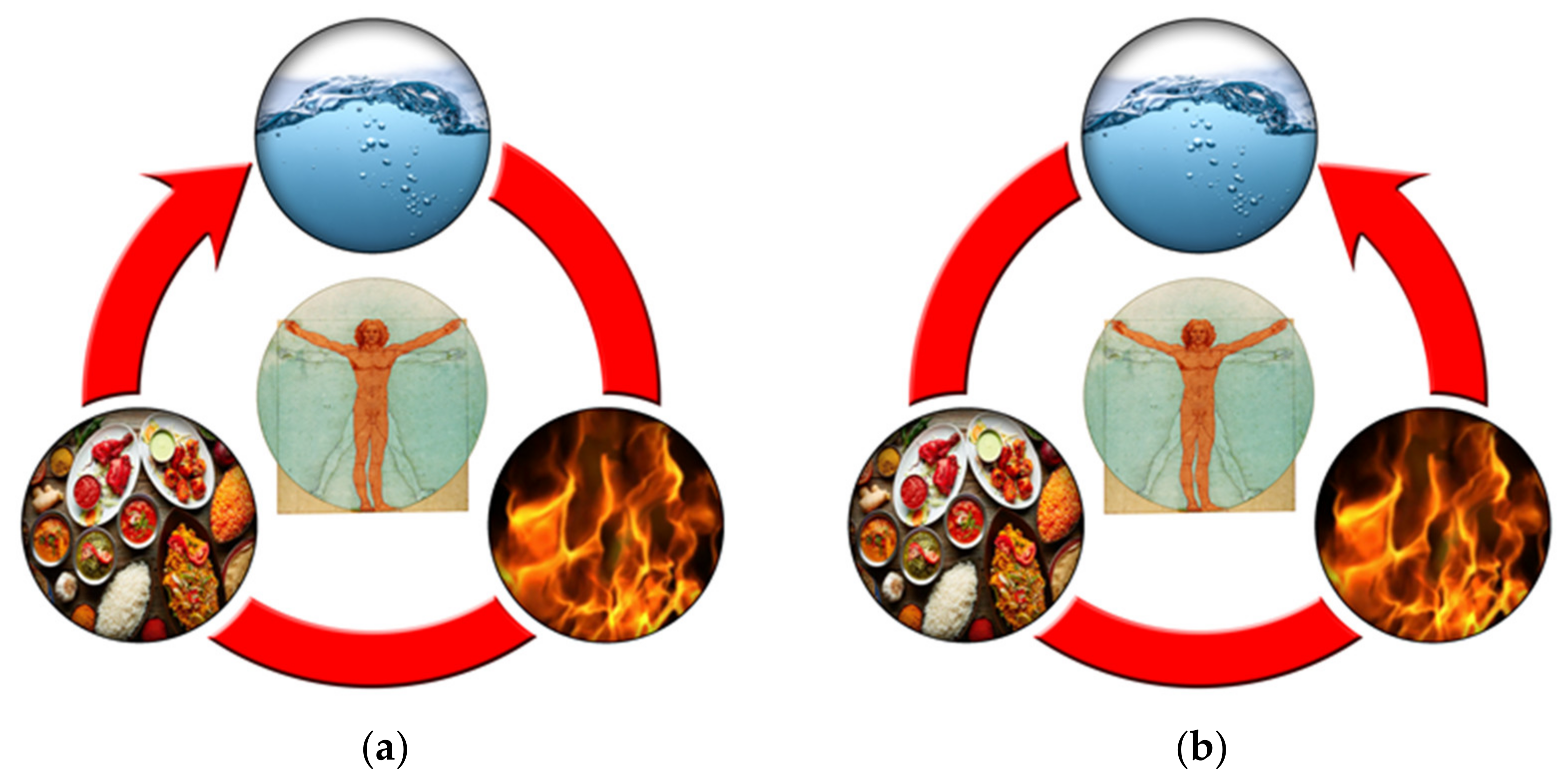
Figure iii. Life expectancy related to freshwater withdrawal: (a) global boilerplate through 1870–2011; (b) boilerplate per land in 2000 [43,44,45,46,47,48].
Figure 3. Life expectancy related to freshwater withdrawal: (a) global average through 1870–2011; (b) boilerplate per state in 2000 [43,44,45,46,47,48].
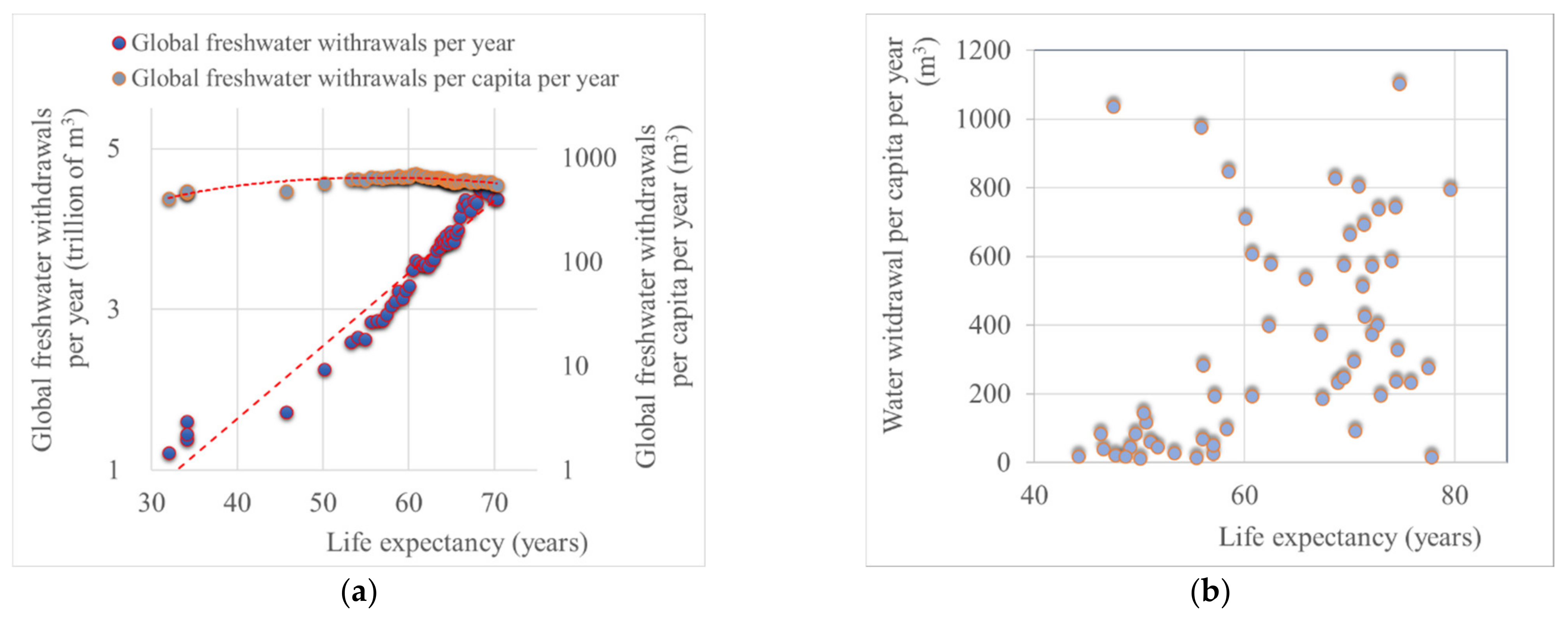
Figure 4. Global spatial data, average per country (2000). Life expectancy, GDP, per capita, and water withdrawal [43,44,45,46,47,48].
Figure four. Global spatial data, average per country (2000). Life expectancy, Gdp, per capita, and water withdrawal [43,44,45,46,47,48].

Effigy v. Life expectancy related to per capita consumption of free energy per year; global average, data from: 1870–2011; state'due south average, data from: 2018 [47,51].
Figure v. Life expectancy related to per capita consumption of energy per year; global average, data from: 1870–2011; land's average, data from: 2018 [47,51].
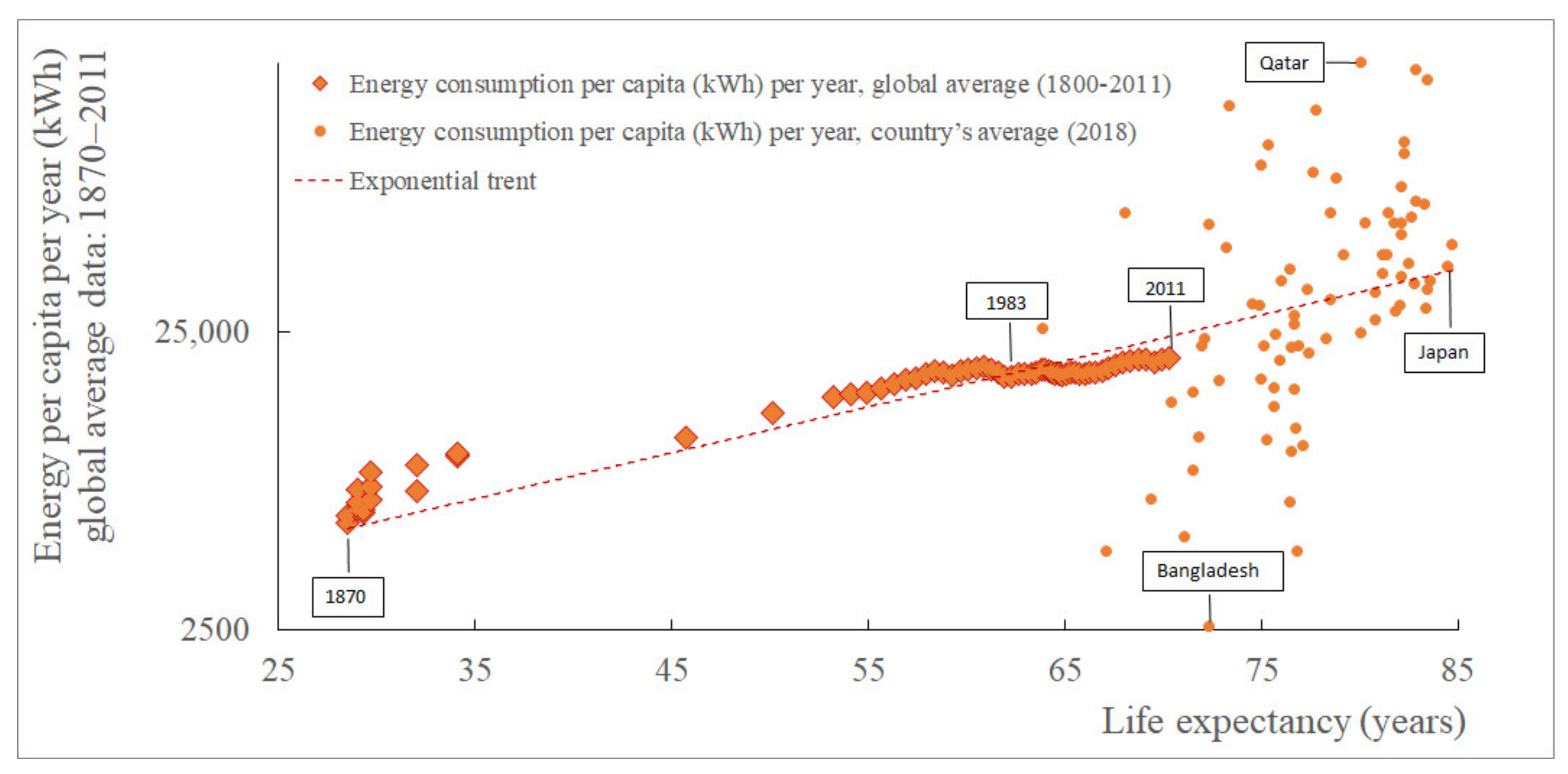
Figure 6. Global spatial data, boilerplate per land (2010). Life expectancy, Gdp, per capita and energy consumption per capita per year [47,48,51,52].
Figure 6. Global spatial information, average per country (2010). Life expectancy, Gdp, per capita and free energy consumption per capita per twelvemonth [47,48,51,52].

Figure seven. Life expectancy related to daily caloric supply; global average (1965–2011) and canton's boilerplate data (2016) [47,57]; UK data (1600–2013) [58].
Effigy 7. Life expectancy related to daily caloric supply; global average (1965–2011) and canton'due south average data (2016) [47,57]; UK data (1600–2013) [58].
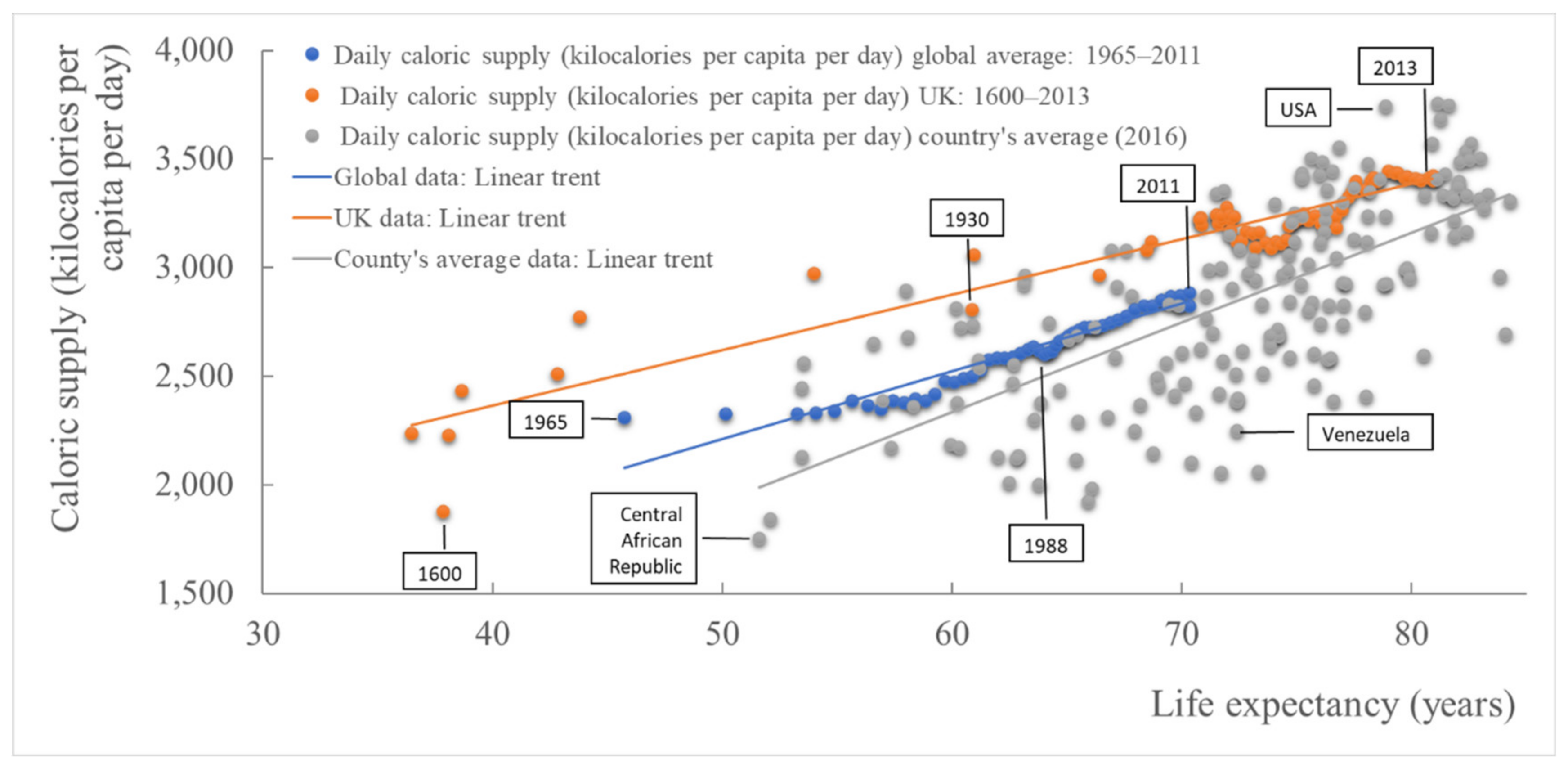
Figure 8. Global spatial information, average per land (2010). Life expectancy, Gdp, per capita, and caloric supply per capita per yr [47,48,57].
Effigy 8. Global spatial data, average per land (2010). Life expectancy, GDP, per capita, and caloric supply per capita per year [47,48,57].

Effigy ix. Evolution of the frequency of appearance in the 78 meg items contained in the Scopus database of scientific articles (the search was conducted over "all fields") until 2020 of the term "h2o food free energy".
Figure 9. Development of the frequency of advent in the 78 meg items contained in the Scopus database of scientific manufactures (the search was conducted over "all fields") until 2020 of the term "water food energy".
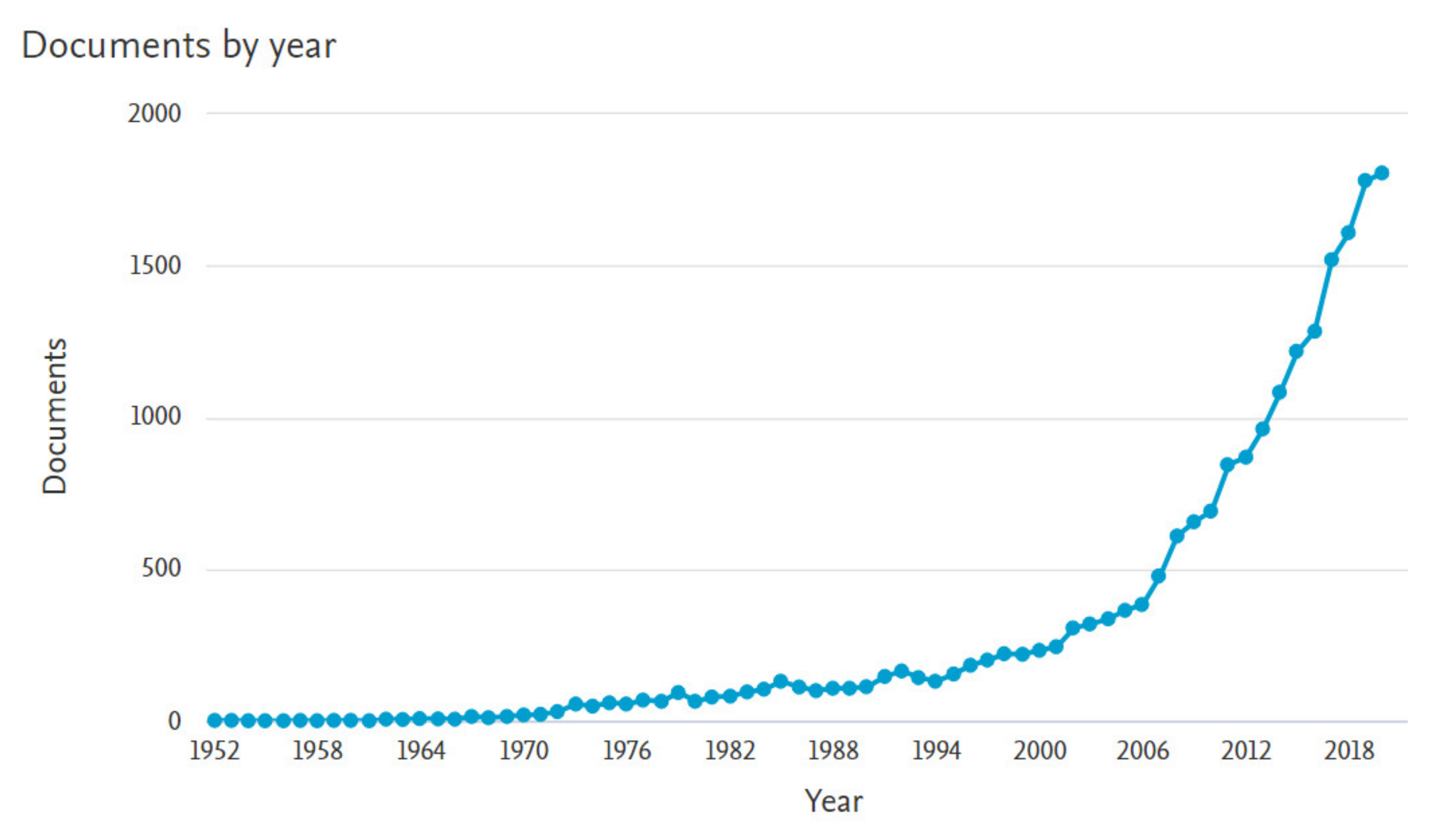
Figure 10. Evolution of the frequency of appearance in the 78 one thousand thousand items contained in the Scopus database of scientific articles (the search was conducted over "all fields") until 2020 of the term "water free energy food nexus".
Figure x. Development of the frequency of appearance in the 78 1000000 items independent in the Scopus database of scientific articles (the search was conducted over "all fields") until 2020 of the term "water free energy food nexus".
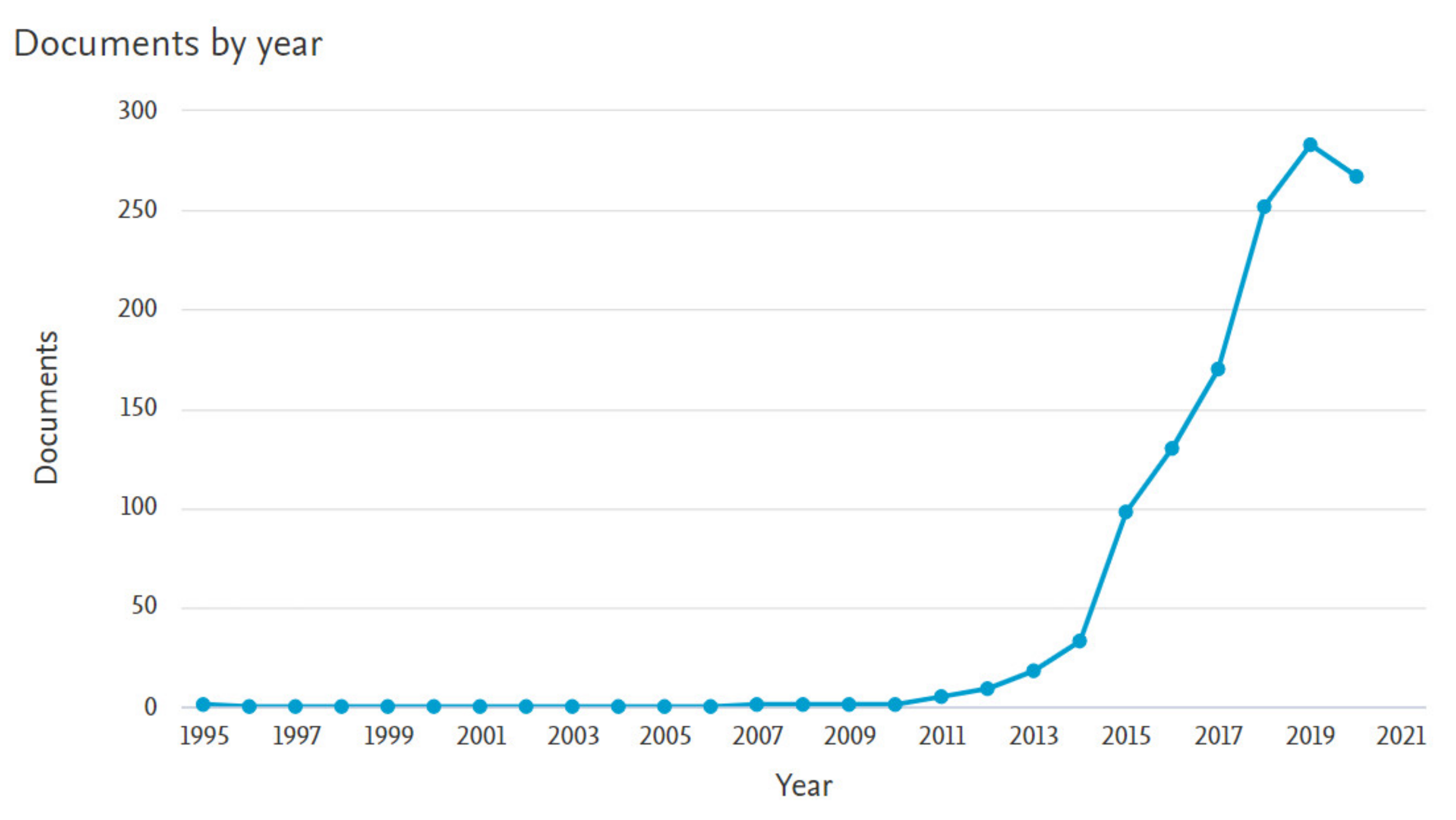
Effigy eleven. Development of the frequency of appearance of the term "water–free energy–food" in the millions of books archived past Google Books.
Effigy eleven. Development of the frequency of advent of the term "water–energy–food" in the millions of books archived by Google Books.

Effigy 12. Country'southward average (2010): exceedance of probability of (a) energy consumption (b) daily caloric supply [51,57].
Figure 12. Land's average (2010): exceedance of probability of (a) energy consumption (b) daily caloric supply [51,57].
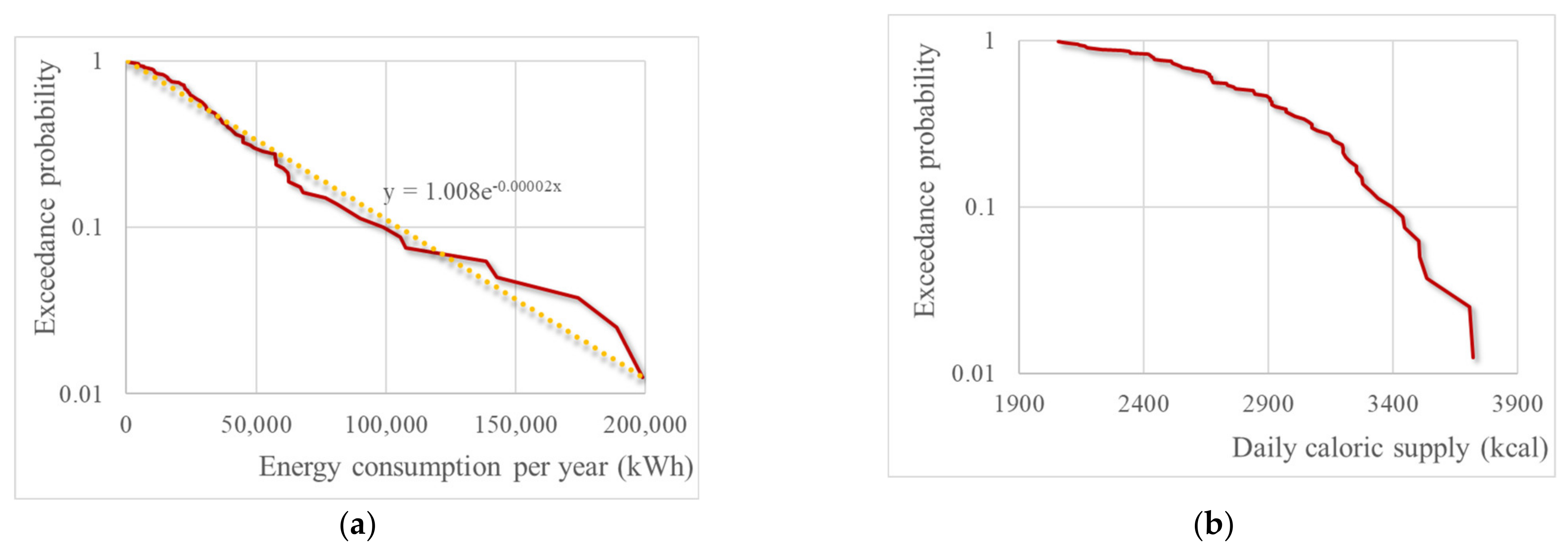
Effigy 13. Country apply of Thessaly (Corine Land Comprehend 2018) [93].
Effigy 13. Land apply of Thessaly (Corine State Comprehend 2018) [93].
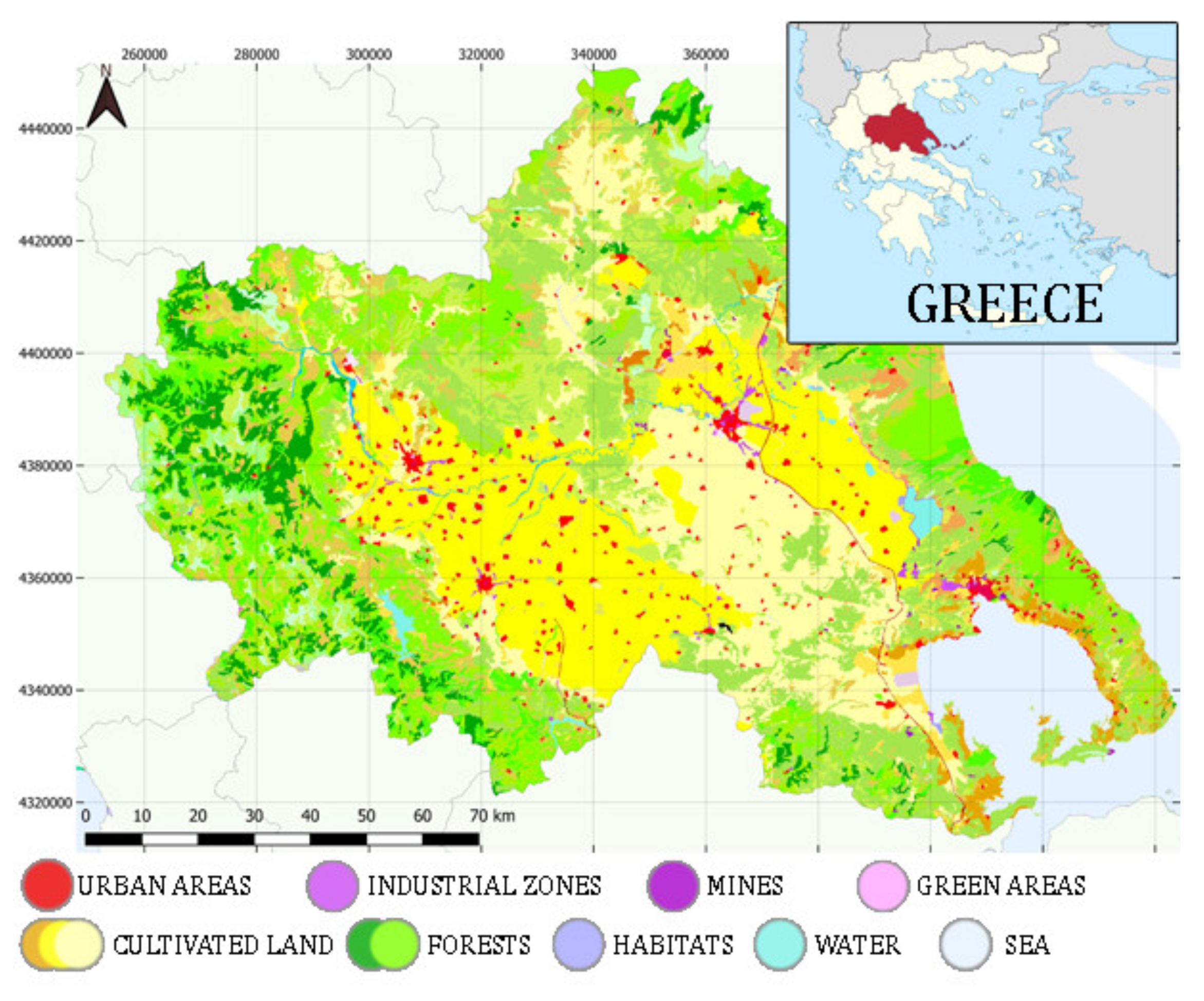
Figure 14. PV panels larger than ane MW in Thessaly's cultivated country [112].
Figure 14. PV panels larger than 1 MW in Thessaly's cultivated land [112].
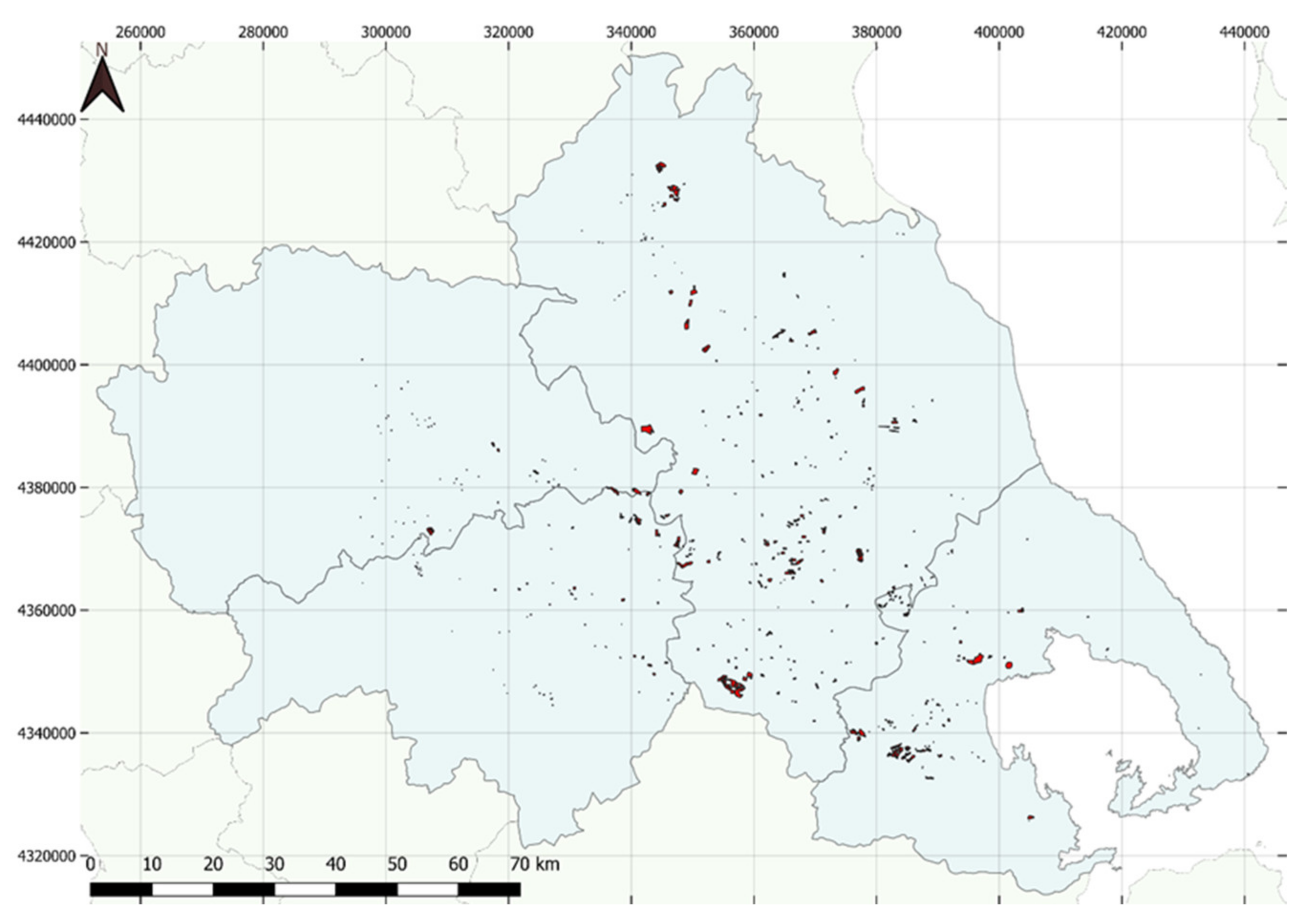
Effigy fifteen. (a) Country use of Thessaly; (b) heat map of the installation of PV panels lager than 1 MW in Thessaly'due south cultivated land.
Figure fifteen. (a) Land utilise of Thessaly; (b) heat map of the installation of PV panels lager than 1 MW in Thessaly'due south cultivated country.
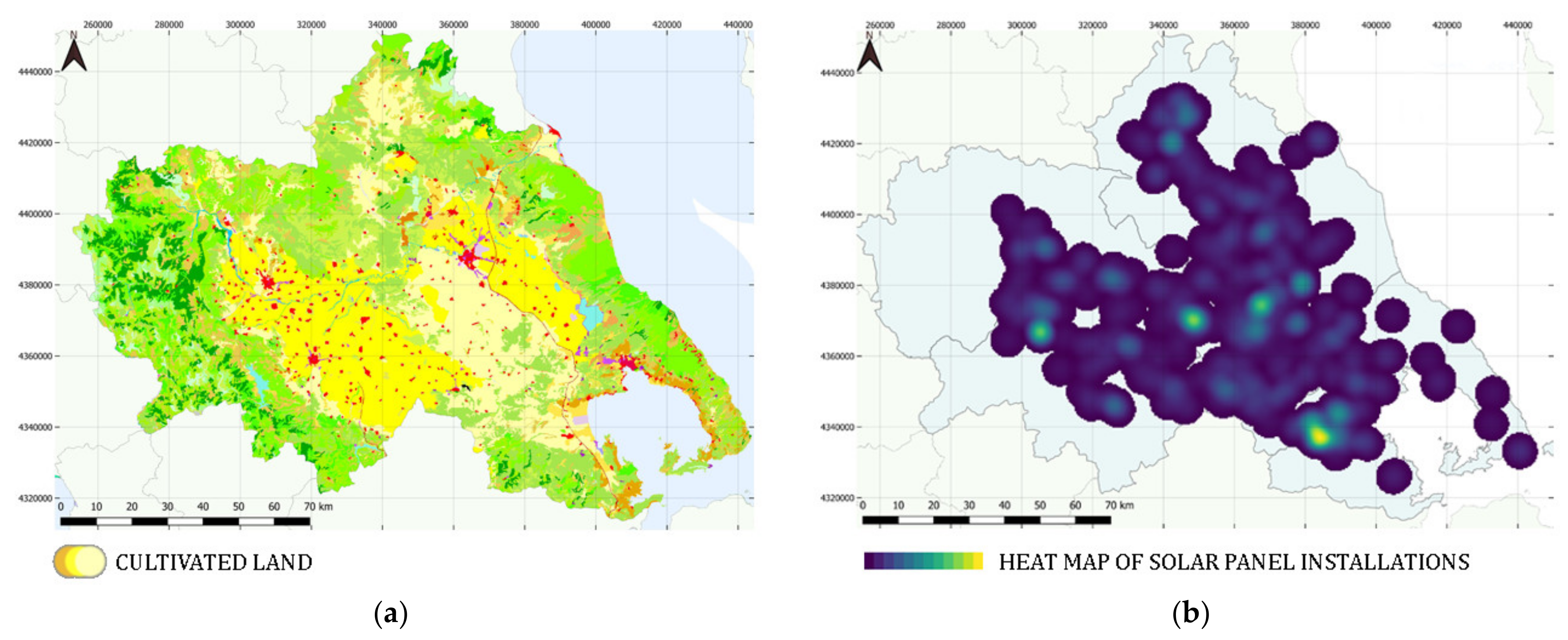
Figure xvi. Climate information of Thessaly (Greece) and different areas in the Yangtze Valley (People's republic of china). (a) Temperature; (b) Rainfall [119].
Effigy sixteen. Climate data of Thessaly (Hellenic republic) and unlike areas in the Yangtze Valley (China). (a) Temperature; (b) Rainfall [119].
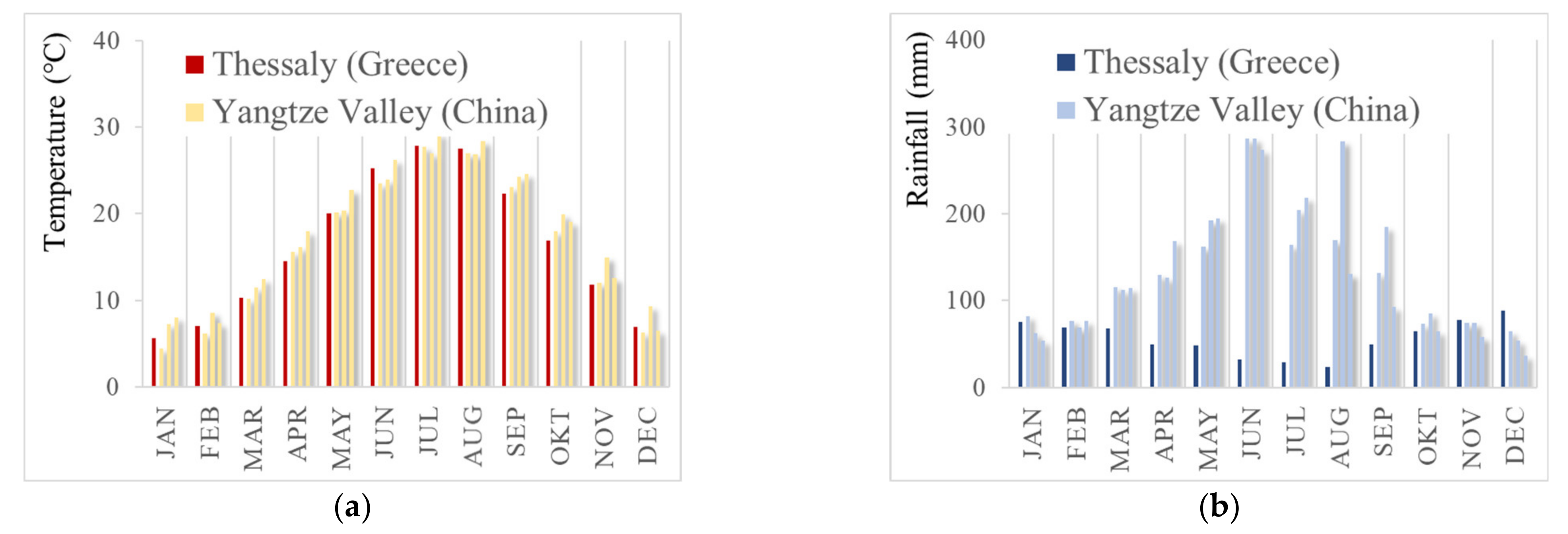
Figure 17. Cumulative financial outflows and inflows for different activities [115].
Figure 17. Cumulative financial outflows and inflows for unlike activities [115].
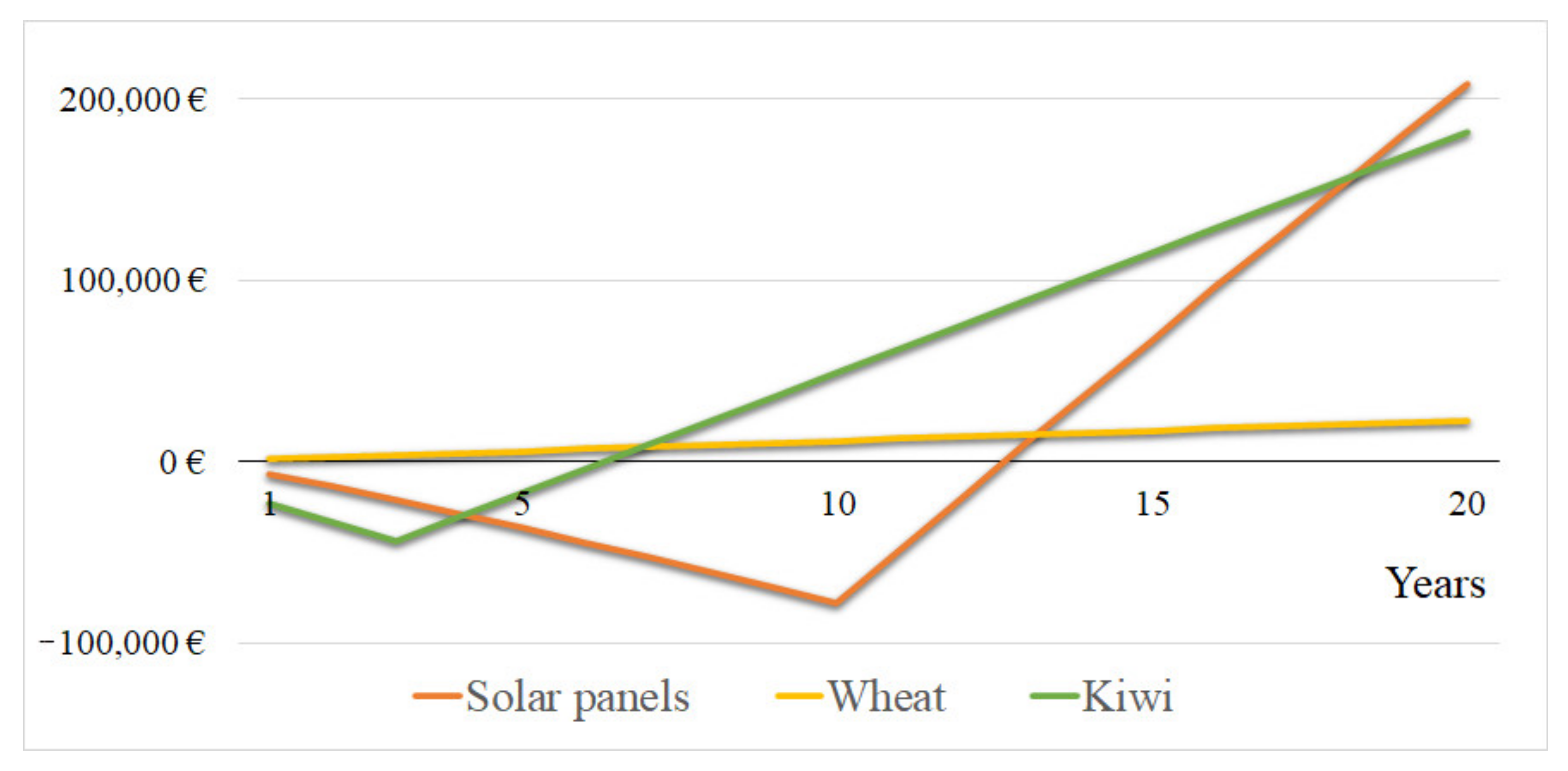
Figure xviii. H2o needs for Thessaly plain if there was simply wheat or kiwifruit.
Effigy eighteen. Water needs for Thessaly evidently if there was but wheat or kiwifruit.

Figure 19. Almanac energy needs and energy product per ha (energy by food is converted from calories to Joule).
Figure 19. Almanac energy needs and energy product per ha (energy by food is converted from calories to Joule).
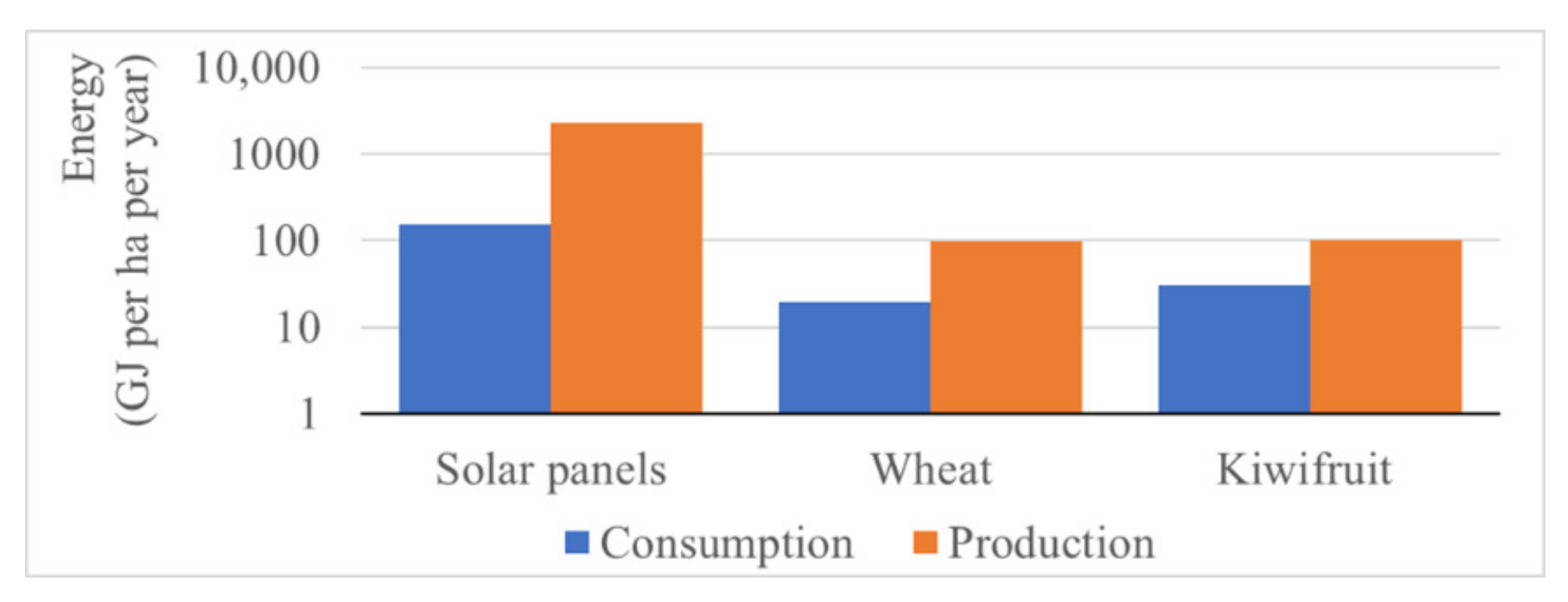
Table 1. Water consumption in Thessaly.
Tabular array ane. Water consumption in Thessaly.
| Type of Consumption | Water Quantity (hm3) |
|---|---|
| Irrigation (2013) | 1306 |
| Municipal h2o | 94 |
| Livestock | 13 |
| Industry | 9 |
| Total | 1422 |
Table 2. PV panel, cultivation of wheat and kiwifruit (annually quantities in Thessaly per ha).
Tabular array 2. PV console, tillage of wheat and kiwifruit (annually quantities in Thessaly per ha).
| Consumption | Product | Conversion of Annual Needs | ||
|---|---|---|---|---|
| PV panels | Energy | 151 GJ * | 2255 GJ | free energy needs of 19 people; average in Greece |
| Water | ** | |||
| Food | ||||
| Wheat | Energy | 19.v GJ [120] | 55.iv–97 GJ *** | ten–19 (people; food) |
| Water | 0–1500 m3 [121] | |||
| Food | four–7 t | |||
| Kiwifruit | Energy | xxx.5 GJ [122] | 100.48 MJ **** | 20 (people; food) |
| Water | 7000–8000 m3 [118] | |||
| Food | - | xl t |
| Publisher's Note: MDPI stays neutral with regard to jurisdictional claims in published maps and institutional affiliations. |
© 2021 past the authors. Licensee MDPI, Basel, Switzerland. This commodity is an open access article distributed under the terms and conditions of the Creative Commons Attribution (CC BY) license (https://creativecommons.org/licenses/past/4.0/).
Source: https://www.mdpi.com/2071-1050/13/16/8935/htm
0 Response to "Photovoltaic Animal Farms Clip Art Photovoltaic on Hog Farms Photos Purchase"
Post a Comment